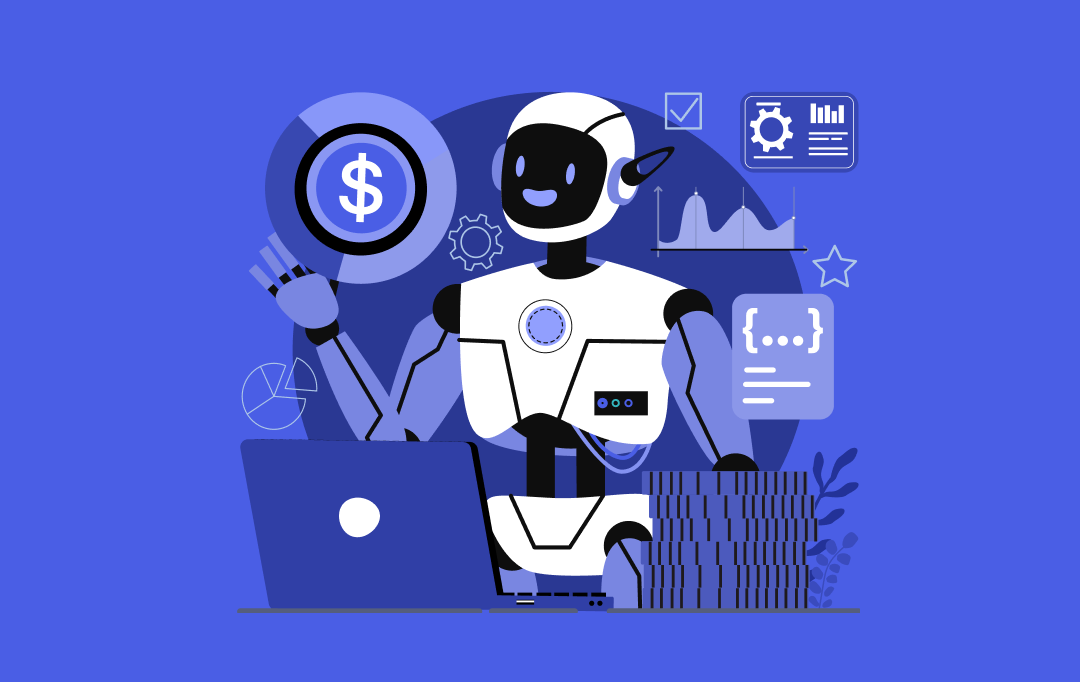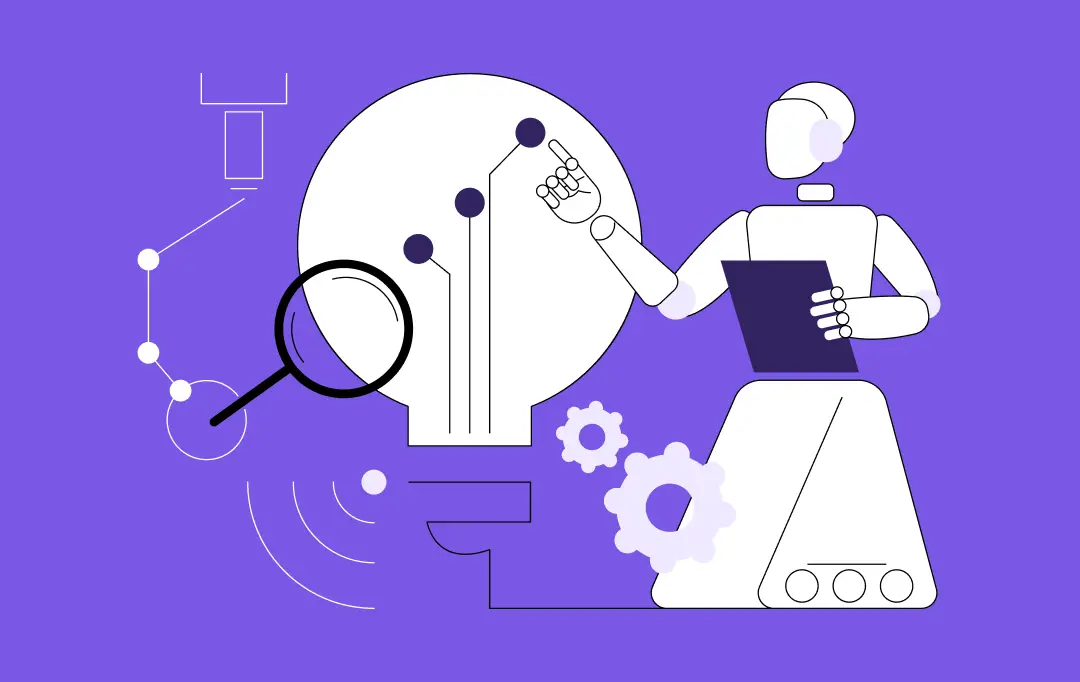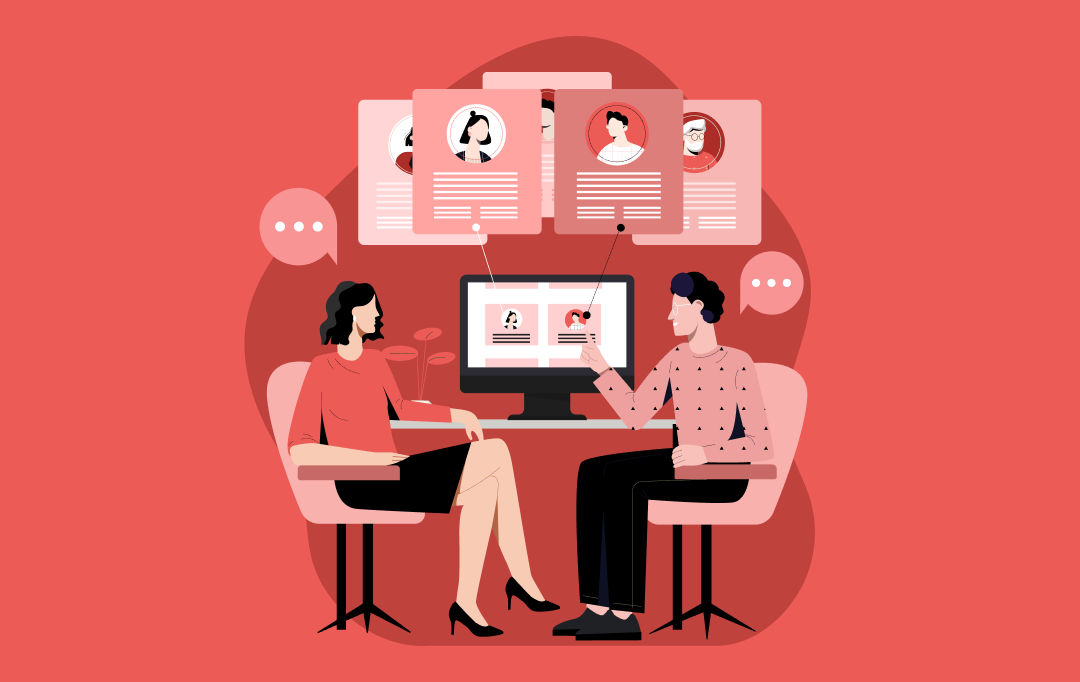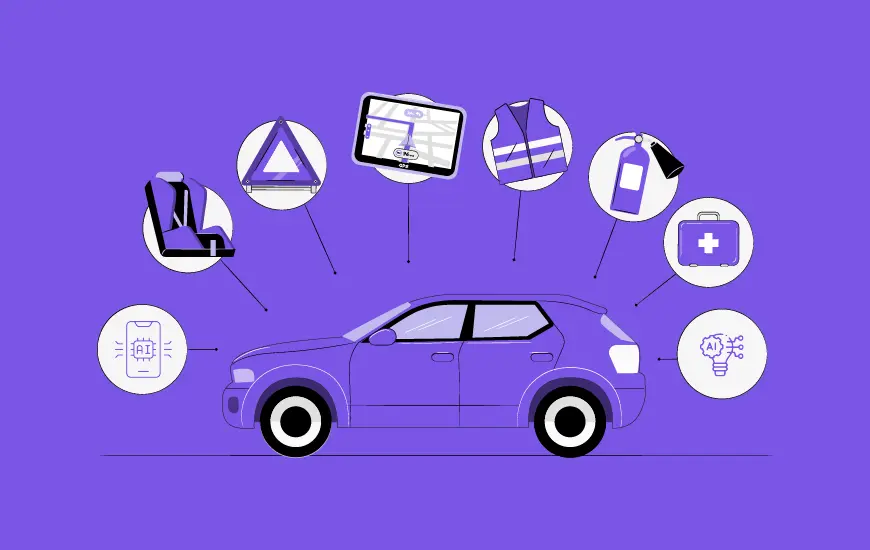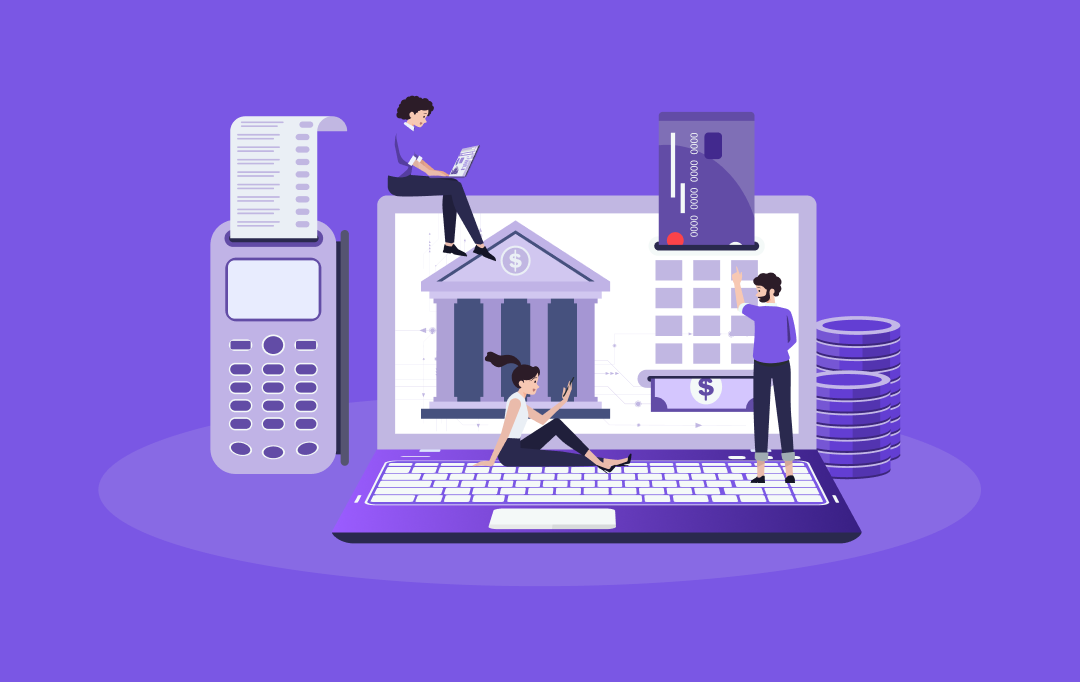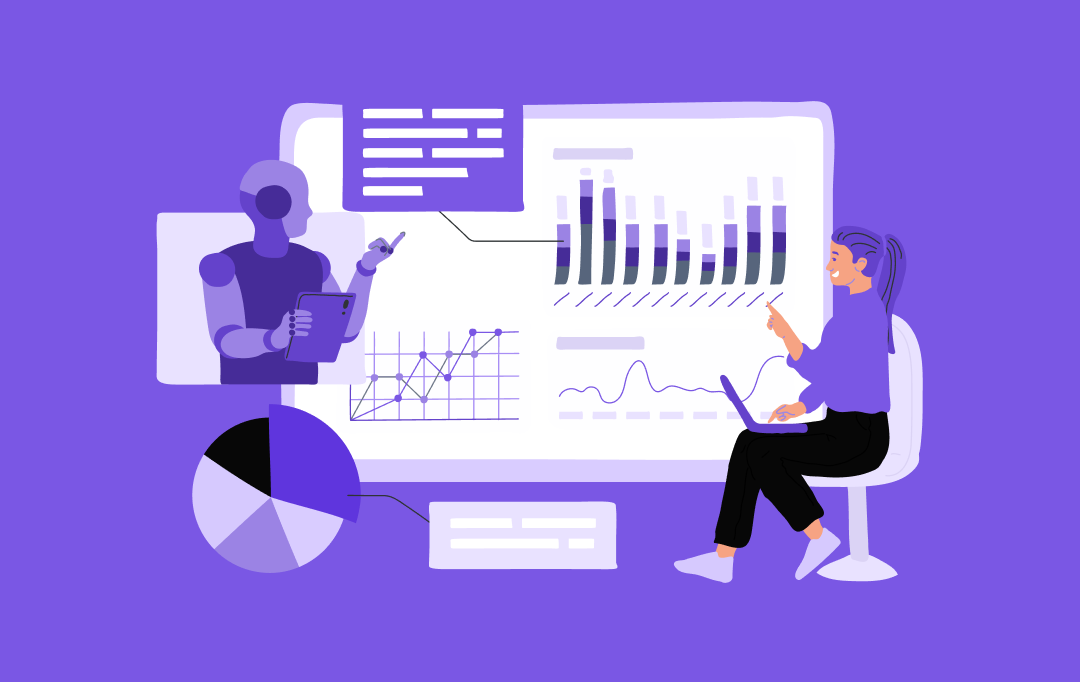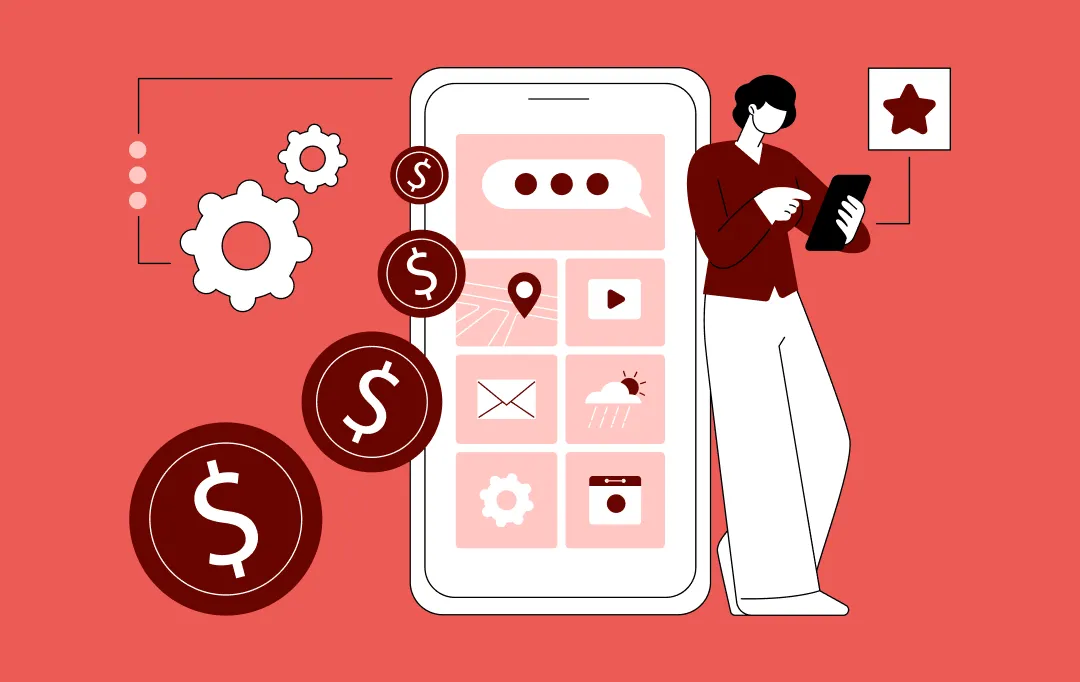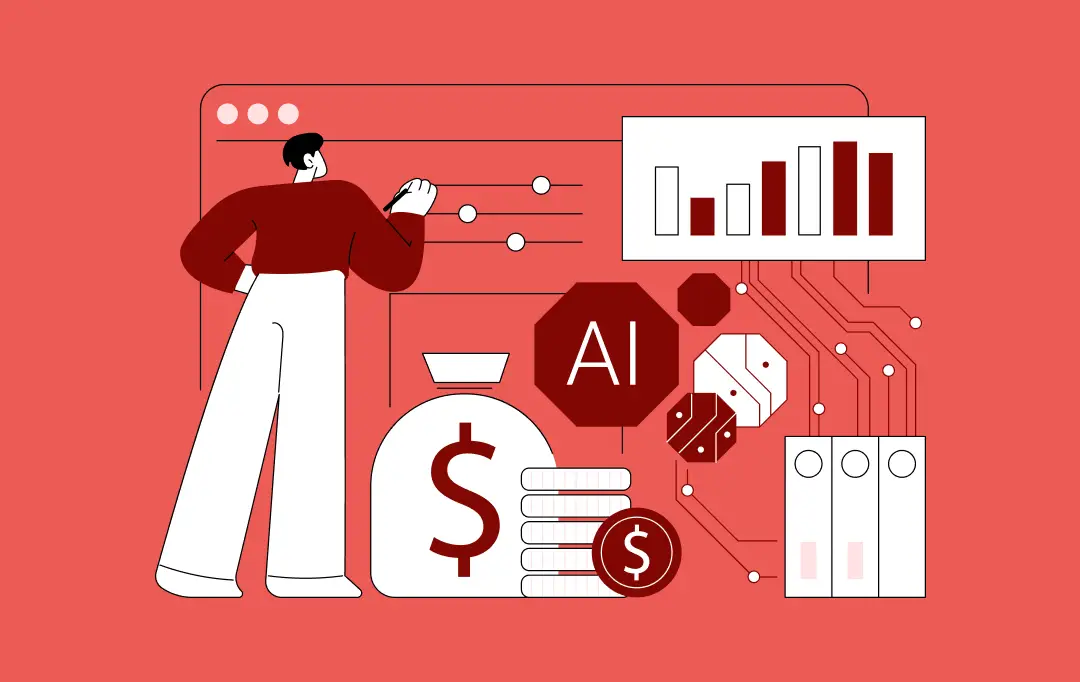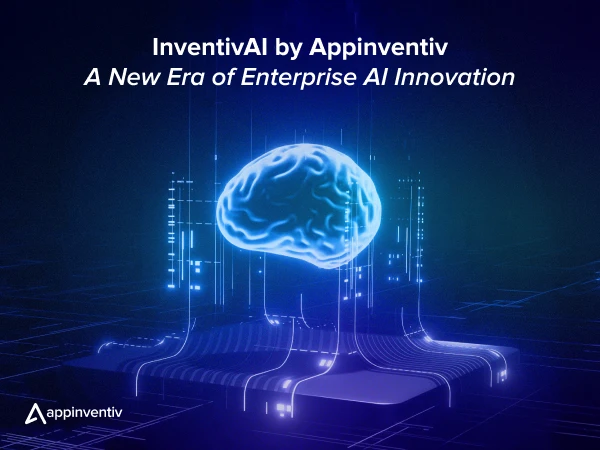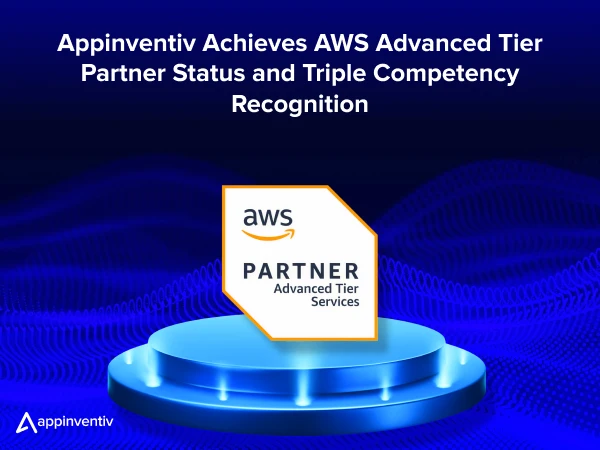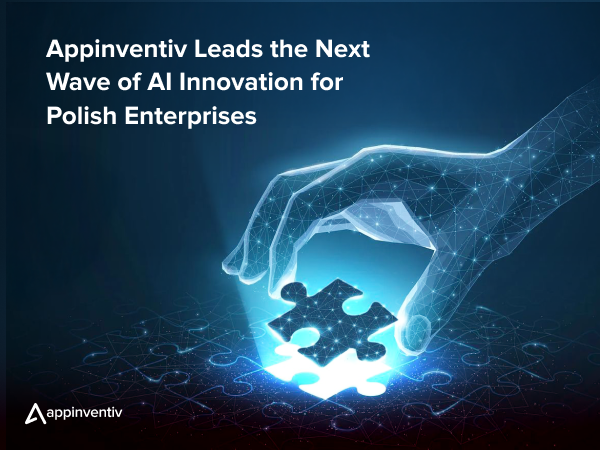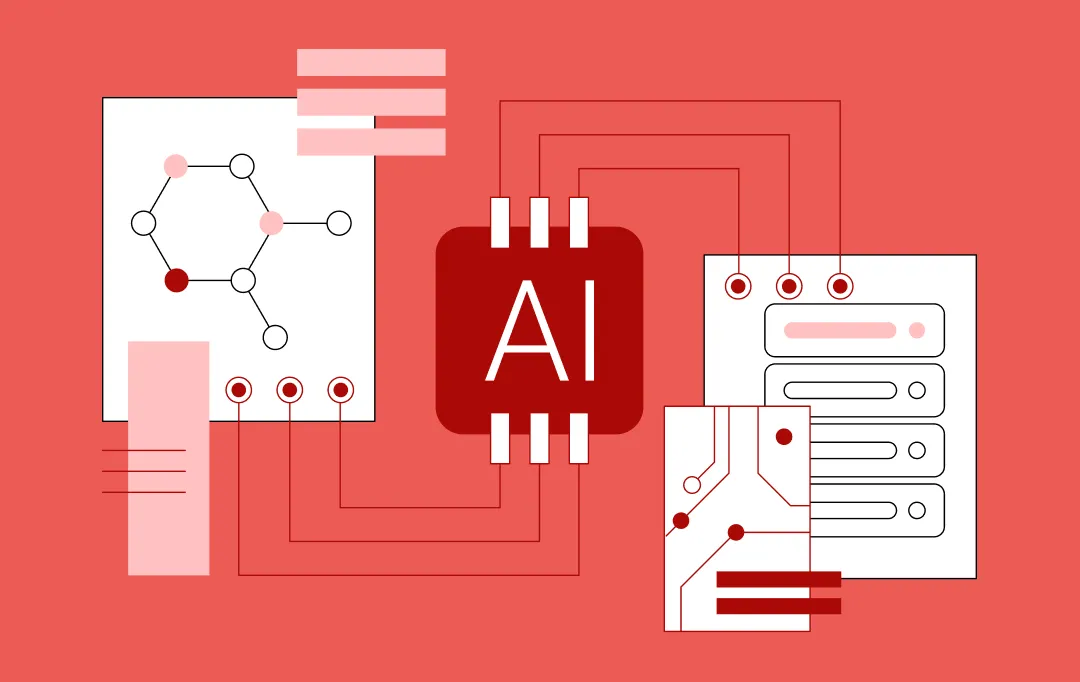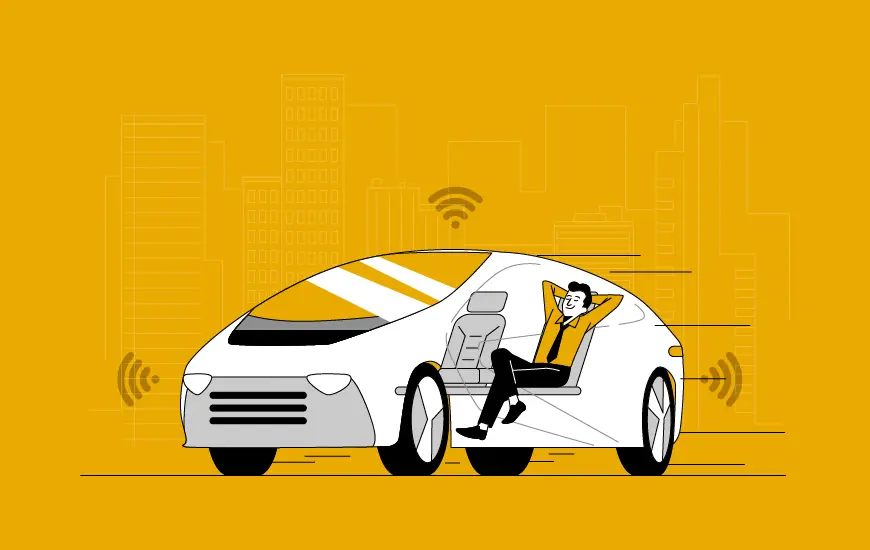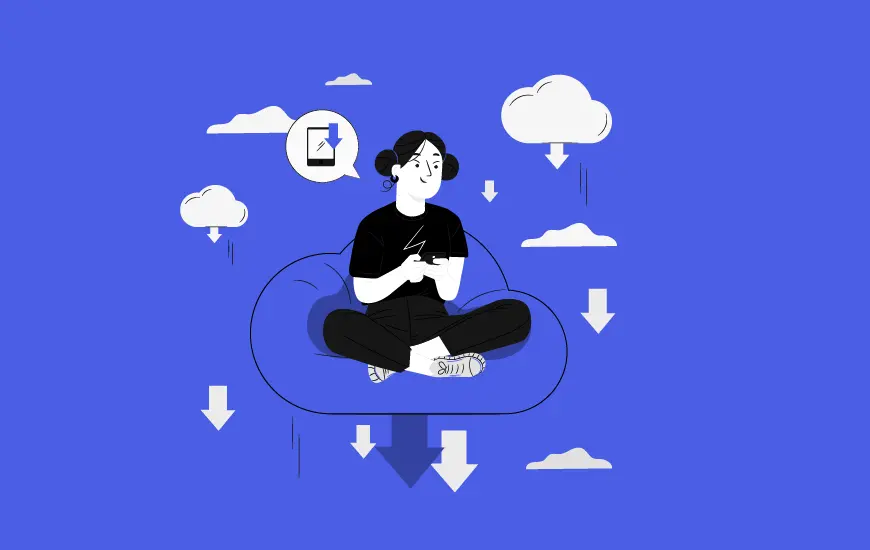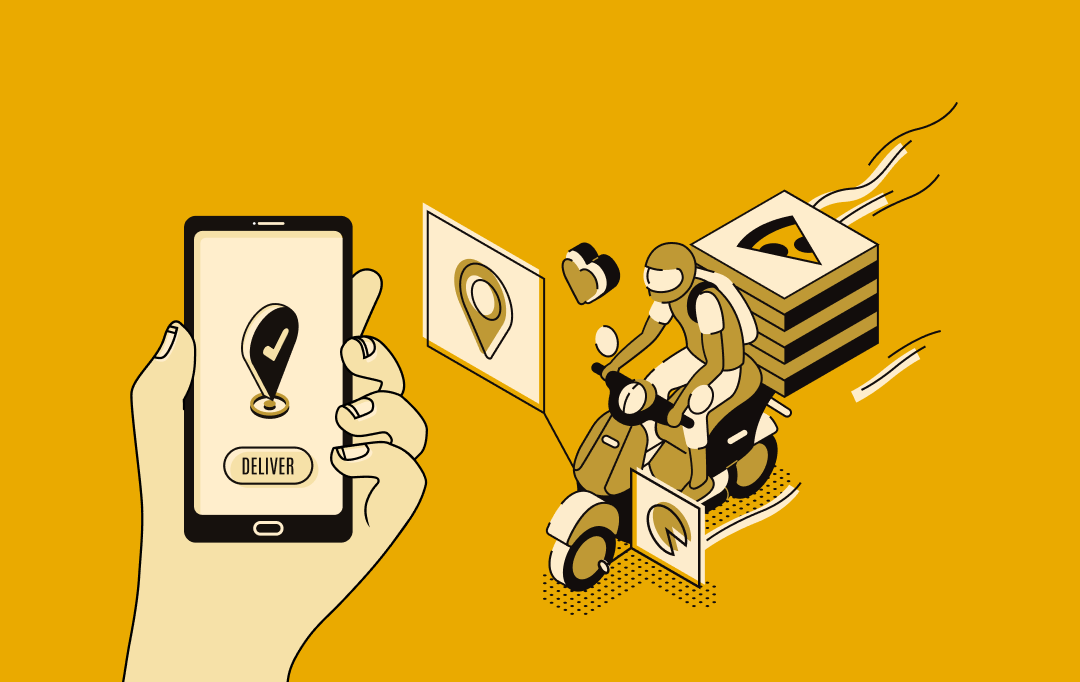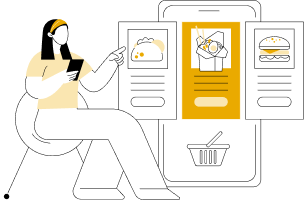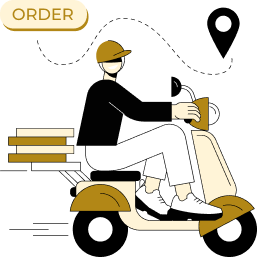- A Glimpse into the Uber Eats App: A Benchmark for Food Delivery Innovation
- How Much Does It Cost to Build an App Like Uber Eats in the US?
- Key Factors Influencing the Cost to Build a Food Delivery App Like Uber Eats in the US
- 1. Feature Complexity
- 2. Platform Choice
- 3. Security & Compliance
- 4. Integration with Existing Systems
- 5. Scalability & Infrastructure
- 6. Customization & Personalization
- 7. UI/UX Design
- 8. Maintenance & Support
- 9. Technology Stack
- 10. Geographic Targeting & Localization
- 11. Testing & Quality Assurance
- Hidden Factors Affecting the Cost to Develop an App Like Uber Eats
- 1. App Store Compliance and Fees
- 2. Third-Party API and SDK Licensing
- 3. Customer Onboarding and Support Tools
- 4. Downtime Management and SLAs
- 5. Data Storage and Backups
- 6. Continuous Testing and Updates
- 7. Localization and Legal Compliance
- 8. Marketing and User Acquisition
- Strategies to Optimize the Cost of Developing a Food Delivery App Like Uber Eats
- Core Features of a Food Delivery App Like Uber Eats
- User-Side Panel
- Driver-Side Panel
- Admin-Side Panel
- Advanced Features to Elevate Your Food Delivery App Like Uber Eats
- Step-by-Step Guide to Developing a Food Delivery App Like Uber Eats
- Conceptualization & Market Research
- Requirement Gathering
- Technology Stack Selection
- UI/UX Design
- Agile Development
- Testing & Compliance Checks
- Deployment & Launch
- Post-Launch Support & Maintenance
- Monetization Strategies for Food Delivery Apps Like Uber Eats
- Why Choose Appinventiv to Develop Your Food Delivery App Like Uber Eats?
- FAQs
Key takeaways:
- Food delivery app costs range from $40K to $200K+.
- Feature complexity and platform choice heavily impact cost.
- Hidden costs include app store fees, APIs, and marketing.
- MVP, cross-platform, and cloud use can optimize budget.
- Essential features: real-time tracking, payments, notifications.
- Advanced features like AI and loyalty programs boost competitiveness.
Being a food delivery company owner, you’re likely swimming upstream—competing in a market that’s dominated by bigger brands such as Uber Eats. The anxiety of not only competing but succeeding is real. Food delivery apps are a part and parcel of everyone’s everyday lives, but it’s not a cakewalk to create a matching product that achieves both loyalty and efficiency like Uber Eats.
Uber Eats revolutionised ordering food as we know it, offering a seamless experience, mind-blowing selection of restaurants, and blazing-fast deliveries. That’s today’s norm, with millions using it daily. But when it comes to businesses looking to replicate its magic, the biggest question is more often not design or features but cost.
So, how much will it cost to build an app like Uber Eats? To give you a brief idea, the development cost may range anywhere between $40,000 and $200,000 or more depending on features, platforms, and tech stack decided upon by a company.
The reality is that providing a service like Uber Eats is a huge undertaking. You have to consider not only the development cost but maintenance, updates, and scaling over a long period as your user base grows. While the expense might scare you at a glance, it’s good to understand the value of developing an app that meets user needs, is of top-class performance, and stands out among all your competition- even UberEats. The right investment in your app is worth it over a long period and is capable of yielding profitability and success in a growing market.
Here, we will break down major cost components in crafting a food ordering and delivery app, minimum features that you are going to need, and what it’ll take to create an Uber Eats-style app that stands out in the highly competitive US market.
Looking to build a food delivery app that balances smart investment with seamless performance?
Let’s Calculate What It Really Takes.
A Glimpse into the Uber Eats App: A Benchmark for Food Delivery Innovation
Uber Eats has become synonymous with food delivery excellence, revolutionizing the way consumers access meals from their favorite restaurants. The platform has scaled into a global giant, serving millions of users every day across diverse markets. With over $13.7 billion in revenue in 2024 (source: BusinessofApps), Uber Eats exemplifies how a seamless user experience, integrated logistics, and a robust tech stack can drive both growth and customer loyalty.
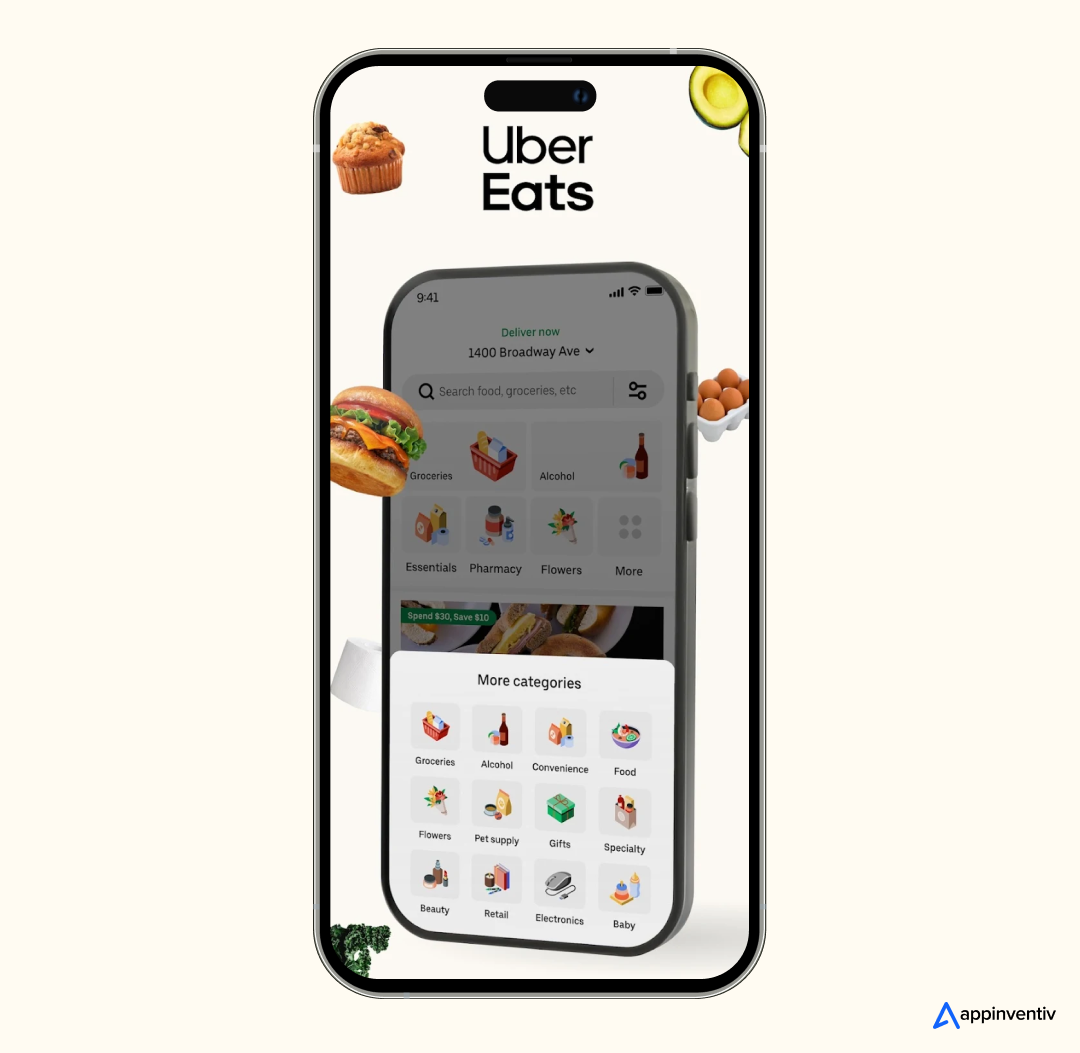
Key to Uber Eats’ success is its user-centric approach, offering a frictionless ordering experience combined with fast, reliable delivery—features that have turned it into a household name. The business model—based on facilitating connections between consumers, restaurants, and drivers—has created a scalable and efficient ecosystem, contributing to the app’s increasing market share year after year.
In addition, real-time tracking and customizable user preferences have made it the go-to app for users, while restaurant partners benefit from easy integration and a steady stream of customers. As per Statista, the online food delivery market is projected to reach $1.39 trillion in 2025.
It is expected to grow at a CAGR of 7.64%, hitting $2.02 trillion by 2030. Uber Eats has positioned itself at the forefront of this trend, demonstrating that there’s immense potential for businesses to leverage this model.
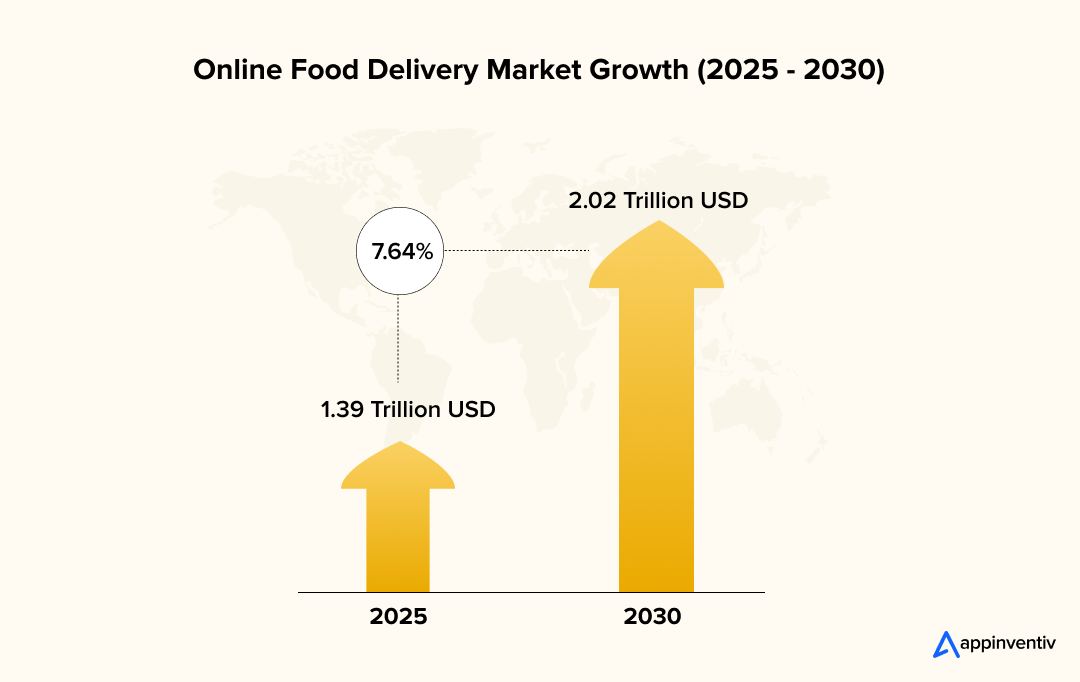
For businesses looking to capitalize on this trend, adopting a similar food delivery app development approach can help increase engagement, drive customer satisfaction, and optimize operational efficiency. By focusing on seamless app design, integration with local restaurant ecosystems, and incorporating key features such as geolocation tracking, order management systems, and payment gateways, businesses can create a competitive edge that drives maximum ROI. As Uber Eats continues to dominate the space, the timing is perfect for businesses to leverage this business model and tap into a rapidly expanding market.
How Much Does It Cost to Build an App Like Uber Eats in the US?
Developing a food delivery app like Uber Eats is no small feat. It’s a complex undertaking that requires a clear strategy, advanced technology, and seamless execution. As revealed earlier, the cost to build an app like Uber Eats varies significantly depending on several factors—such as the complexity of features, platform choices, and the scale of operations you plan to support.
Typically, the cost to develop a food delivery app like Uber Eats can range from $40,000 for a basic minimum viable product (MVP), designed with essential features, to over $200,000 for a fully functional app with advanced features like real-time tracking, payment systems, and robust backend infrastructure. The price varies based on the tech stack, design elements, and integrations required for a seamless user experience and operational efficiency.
Here’s a breakdown of how you can estimate the cost for building a food delivery app:
Development Time × Hourly Rate = Total Development Cost
- Development Time refers to the total hours your team will spend designing, coding, and testing the app. The complexity of the app and the number of features you want to include can significantly influence the timeline.
- Hourly Rate varies depending on the expertise of your hired app development team.
To give you a clearer picture, here’s a general breakdown of the phases involved in building an Uber Eats-like app:
| Phase | Timeline | Estimated Cost |
|---|---|---|
| Research & Planning | 2–4 weeks | $3,000 – $10,000 |
| UI/UX Design | 3–6 weeks | $5,000 – $20,000 |
| Core Development | 3–6 months | $20,000 – $120,000 |
| Security & Compliance | Ongoing | $10,000 – $40,000 |
| Testing & QA | 1–2 months | $8,000 – $25,000 |
| Deployment & Launch | 2–4 weeks | $2,000 – $10,000 |
| Maintenance & Updates | Ongoing (monthly) | $1,000 – $10,000/month |
Once you have an understanding of the overall costs involved in developing a food delivery app, it’s essential to realize that each phase of development affects your timeline and budget. Decisions made during the design and feature integration stages will directly impact the final product and its ability to scale efficiently as your user base grows.
Key Factors Influencing the Cost to Build a Food Delivery App Like Uber Eats in the US
When budgeting for your food delivery app development, several key cost drivers will shape your budget and timeline. Let’s break down these factors to give you a clear understanding of what influences the overall Uber Eats-like app development cost:
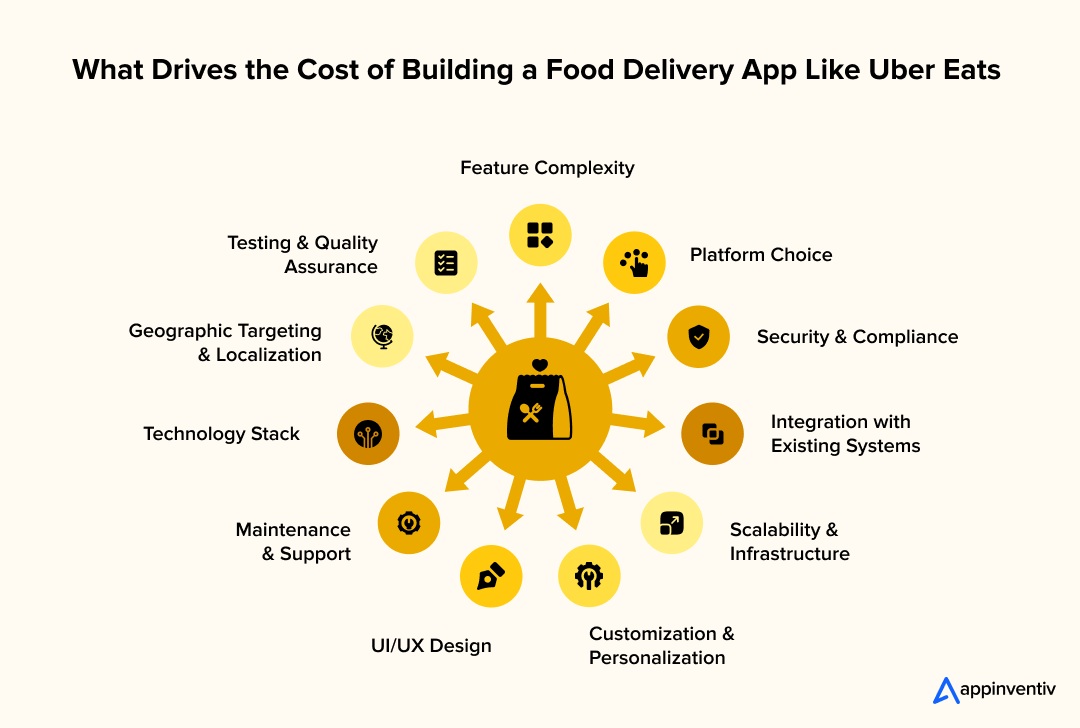
1. Feature Complexity
The complexity of the features you choose to implement plays a significant role in determining development time and costs. Basic features like order placement and restaurant listings are simpler to build and faster to launch. However, advanced functionalities like real-time tracking, AI-based recommendations, and multi-currency payment support require more development resources, longer timelines, and higher costs. The more sophisticated the features, the greater the development effort and associated expenses.
Here’s a quick insight into the Uber Eats app development cost breakdown as per different levels of complexity:
| Complexity Level | Estimated Development Time | Estimated Cost (USD) |
|---|---|---|
| Basic | 3–6 months | $40,000 – $60,000 |
| Moderate | 6–9months | $80,000 – $120,000 |
| Advanced | 9–12 months | $140,000 – $200,000 |
2. Platform Choice
Choosing between native apps for iOS and Android or a cross-platform solution like React Native can significantly affect the cost to build an app like Uber Eats. Native apps generally provide better performance and allow for the use of device-specific features, but developing separate apps for iOS and Android means doubling the work. A cross-platform approach may reduce costs but can sometimes compromise the customization of the user experience. Your choice of platform strategy directly impacts development time and costs for building a food delivery app like Uber Eats.
3. Security & Compliance
Security is paramount in food delivery apps and is one of the major factors affecting the cost of developing an app similar to Uber Eats. When it comes to handling sensitive user data and transactions, compliance with data protection regulations such as GDPR for privacy or local data laws must be ensured. Implementing robust encryption, secure authentication mechanisms, and compliance with financial and payment industry standards adds complexity to the development process and increases costs.
4. Integration with Existing Systems
If your food delivery platform needs to integrate with existing restaurant POS systems, delivery partner platforms, or third-party payment gateways, it will require specialized development efforts. Custom connectors, middleware solutions, and rigorous testing are required to ensure seamless integration, which can further increase the Uber Eats-like app development cost.
[Also Read: Cloud-Based POS vs Legacy POS Systems: What to Choose for your Restaurant Business?]
5. Scalability & Infrastructure
As your app grows, ensuring it can handle increasing orders, user traffic, and restaurant partnerships is critical. Cloud solutions like AWS, Google Cloud, or Microsoft Azure provide the infrastructure needed to scale, ensuring smooth performance even under heavy load. However, planning for scalable backend infrastructure—supporting load balancing, disaster recovery, and efficient data management—adds complexity and cost to your food delivery app development.
6. Customization & Personalization
Offering personalized user experiences, such as AI-driven restaurant recommendations, customized offers, and order history analysis, can increase user engagement. These features require advanced machine learning algorithms, continuous data management, and personalized content, all of which demand a higher development budget. Incorporating advanced customization into your app helps differentiate your platform from others like Uber Eats and can drive long-term customer loyalty.
7. UI/UX Design
A seamless, user-friendly interface is crucial in food delivery apps. The design must not only be visually appealing but also easy to navigate, offering an intuitive flow from browsing restaurants to completing an order. UI/UX design includes user research, prototyping, testing, and accessibility adjustments, which contribute to the overall food delivery app development cost. Investing in high-quality design upfront helps reduce costly redesigns in the future and builds user trust, essential for the success of an app like Uber Eats.
8. Maintenance & Support
Once your app is launched, ongoing maintenance and updates are crucial for keeping it secure, bug-free, and aligned with user expectations. This includes implementing new features, fixing bugs, and ensuring that the app works smoothly across various devices and platforms. Depending on the complexity and scale, maintenance can add to the ongoing Uber Eats-like app development cost, including support for new devices, operating systems, and user feedback.
9. Technology Stack
Choosing the right tech stack for food delivery app like Uber Eats is fundamental for both the performance and scalability. Whether it’s selecting the programming languages, frameworks, or databases, the right tech stack directly influences the development speed, future upgrades, and long-term maintenance costs. Cutting-edge technologies such as React Native, Node.js, or Cloud-based solutions may come at a higher initial cost, but they can reduce long-term expenses by improving app performance and reducing downtime.
10. Geographic Targeting & Localization
If your app similar to Uber Eats is targeting multiple regions or countries, localization becomes crucial. This means adapting the app for different languages, currencies, time zones, and local regulations. Localization can add layers of complexity to the development process and increase the overall cost to build an app like Uber Eats. However, it is essential to ensure a seamless user experience for customers in different geographical locations that can ultimately help in increasing the app’s market reach and appeal.
11. Testing & Quality Assurance
Quality assurance (QA) and thorough testing are essential for ensuring your app functions flawlessly across all devices and operating systems. This includes functional testing, performance testing, security audits, and usability assessments. Comprehensive QA is time-consuming but necessary to deliver a high-quality app that meets users’ expectations and builds trust in your platform.
Hidden Factors Affecting the Cost to Develop an App Like Uber Eats
The development costs for a food delivery app are more straightforward to estimate. However, businesses must understand that there are several hidden expenses that often act as the challenges in building an app like Uber Eats. These hidden costs can significantly impact your overall budget, especially as you scale, launch, and provide post-launch support. Here are some hidden factors that can affect the development of an Uber Eats-like platform:
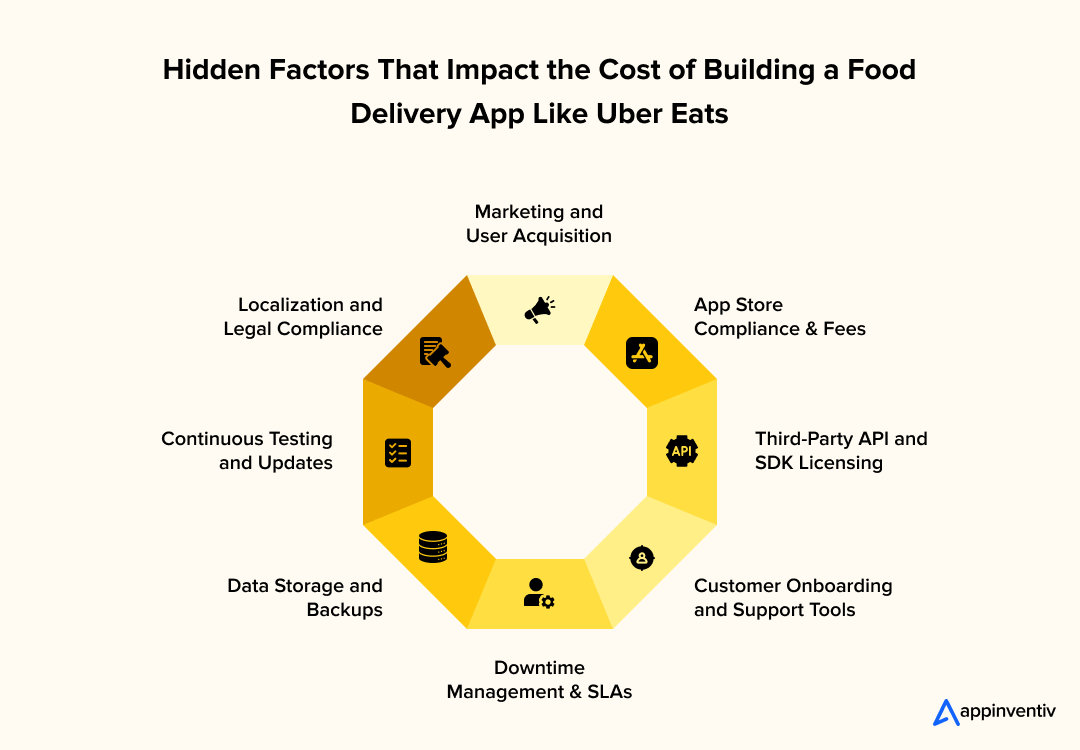
1. App Store Compliance and Fees
When submitting your food delivery app to the Apple App Store or Google Play, you’ll need to follow strict guidelines set by each platform. These guidelines may involve various app feature requirements, legal documentation, and even design specifications. Additionally, both stores charge annual developer fees, which are recurring costs. Any delays during the approval process can slow down your launch timeline, making it crucial to factor in these costs early on.
2. Third-Party API and SDK Licensing
To offer features such as real-time tracking, payment processing, or push notifications, your Uber Eats-like app may need to integrate third-party APIs or SDKs. These external services often come with licensing or usage-based fees, which can increase the cost to make an app like Uber Eats over time. As your app scales and the number of users grows, these fees may increase, making it essential to plan for the ongoing costs associated with third-party services.
3. Customer Onboarding and Support Tools
A seamless customer onboarding experience is crucial for food delivery apps to ensure smooth user acquisition and engagement. Integrating tools like live chat, automated onboarding assistants, or in-app tutorials adds to both development and operational cost to build an app like Uber Eats. Additionally, providing responsive customer support through chatbots or help desks requires continuous investment to maintain high service standards and resolve user queries quickly.
4. Downtime Management and SLAs
To ensure your Uber Eats-like platform is available around the clock, especially during high-traffic periods like lunch or dinner, you’ll need to invest in premium cloud services or backup systems. These services typically come with Service Level Agreements (SLAs) to guarantee uptime and performance. Ensuring 24/7 availability means additional costs for cloud infrastructure, load balancing, and disaster recovery solutions.
5. Data Storage and Backups
As your app collects more user data, including order history, payment information, and delivery preferences, secure data storage becomes essential. Regular backups and disaster recovery plans must be in place to protect your customers’ information and ensure your platform’s reliability. Over time, the costs for cloud storage and backups can add up, particularly as the user base grows and more data is generated.
6. Continuous Testing and Updates
Post-launch testing and continuous app updates are critical for maintaining the performance and security of your food delivery app. As technology and user needs evolve, your app will require regular updates to stay compliant with security regulations and address potential bugs. Frequent testing ensures smooth functionality, which translates into ongoing costs for development teams, especially in the fast-evolving food delivery industry.
7. Localization and Legal Compliance
If you plan to launch your food delivery app in multiple regions or countries, localization is a key consideration. This means adapting the app to support different languages, currencies, and local food delivery regulations. These adjustments not only increase development costs but also require legal reviews to comply with local data protection and food service laws. Each region adds a layer of complexity, contributing to higher overall expenses.
8. Marketing and User Acquisition
While having a great app is essential, it won’t attract users without an effective marketing strategy. Budgeting for user acquisition campaigns, app store optimization, and promotional activities is crucial for driving downloads and engagement. Whether it’s through paid ads, social media promotions, or influencer partnerships, allocating funds for marketing efforts ensures your Uber Eats-like platform reaches its target audience. Often, this expense is overlooked until the app is ready to launch.
Strategies to Optimize the Cost of Developing a Food Delivery App Like Uber Eats
Building a feature-rich, scalable food delivery app like Uber Eats can be a significant investment. However, with the right strategies in place, you can optimize your development costs without compromising on quality or security. Below is a breakdown of key cost optimization strategies used by industry leaders to balance quality, speed, and budget effectively:
| Strategy | How It Optimizes Cost |
|---|---|
| Start with an MVP | Focus on essential features first to launch quickly, gather real user feedback, and avoid spending on unused functions early on. |
| Cross-Platform Development | Use frameworks like React Native or Flutter to build for iOS and Android simultaneously, reducing duplication of effort and shortening development time. |
| Leverage Open-Source Tools | Incorporate trusted open-source libraries and components to accelerate development and lower licensing fees. |
| Prioritize Security Early | Integrate security and compliance requirements from the start to avoid costly rework and ensure regulatory adherence. |
| Automate Testing & Deployment | Use Continuous Integration/Continuous Deployment (CI/CD) pipelines and automated tests to speed releases, reduce manual errors, and ensure app stability. |
| Modular Architecture | Build your app with modular, reusable components that simplify updates, making it easier to maintain and reduce long-term development cost to build an app like Uber Eats. |
| Cloud Infrastructure | Opt for scalable cloud solutions like AWS, Google Cloud, or Microsoft Azure, paying only for the resources used and easily adjusting capacity as needed. |
| Iterative Development | Develop in phases with regular user feedback loops, refining features efficiently and avoiding unnecessary functionality. |
| Outsource Strategically | Partner with specialized outsourcing teams for complex components to leverage expertise, reduce overhead, and streamline the Uber Eats app development process. |
Core Features of a Food Delivery App Like Uber Eats
A successful food delivery app like Uber Eats combines usability, security, and rich functionality to meet modern consumer expectations. Here are the key features of the Uber Eats app that also act as backbone of any competitive food delivery platform:
User-Side Panel
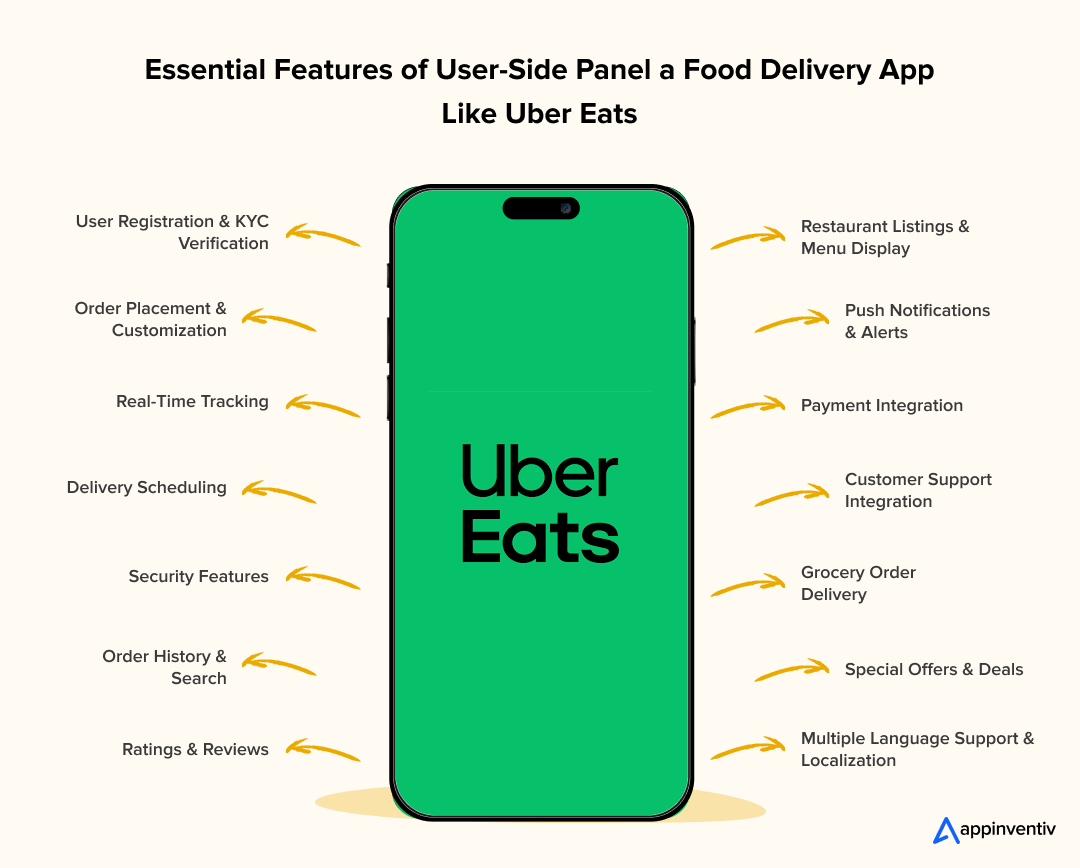
User Registration & KYC Verification
Secure onboarding with identity checks, document uploads, and multi-factor authentication to comply with regulations and prevent fraud.
Restaurant Listings & Menu Display
Easy browsing of restaurants with comprehensive menu details, ratings, and availability to help users make quick decisions.
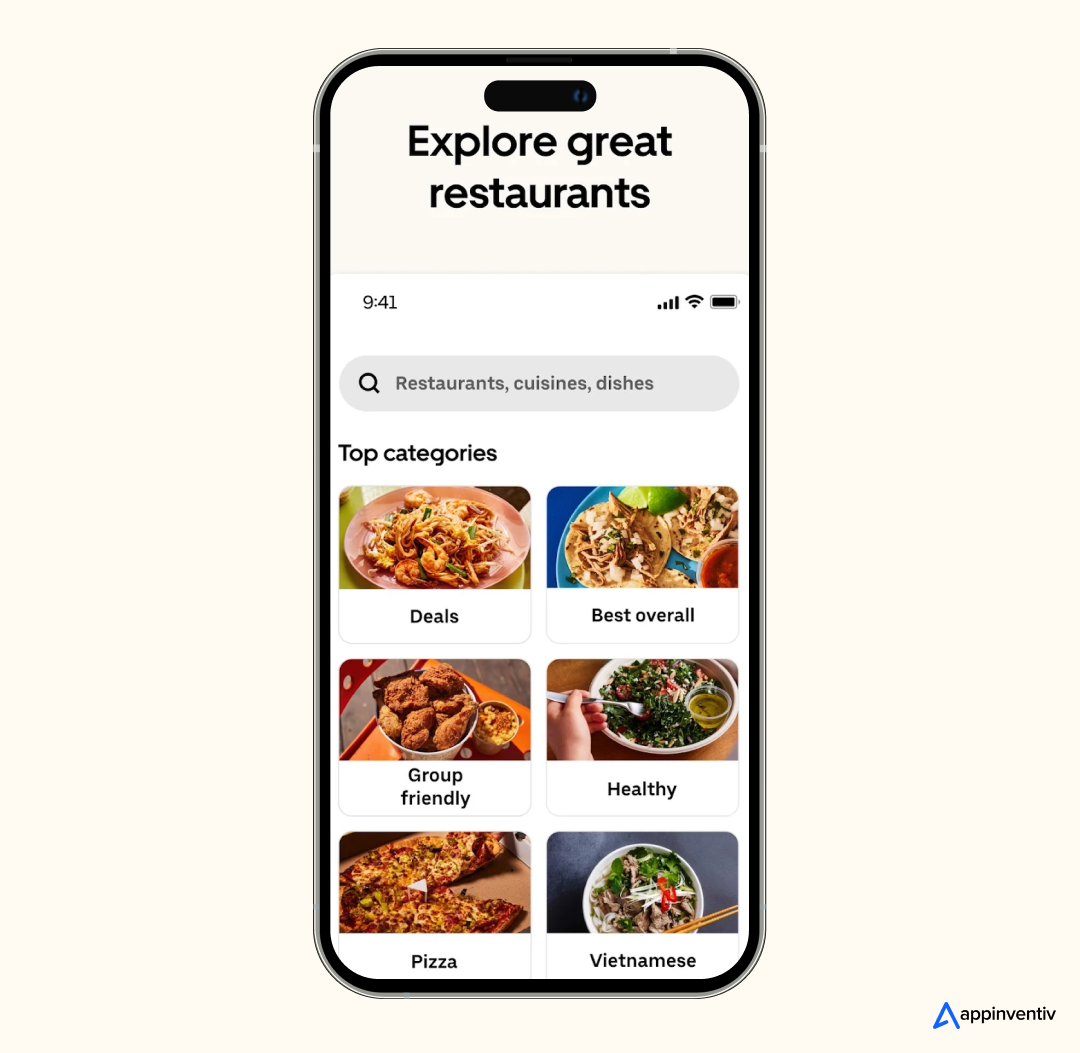
Order Placement & Customization
Simple, customizable ordering process with options for modifying items, adding special requests, and selecting quantities.
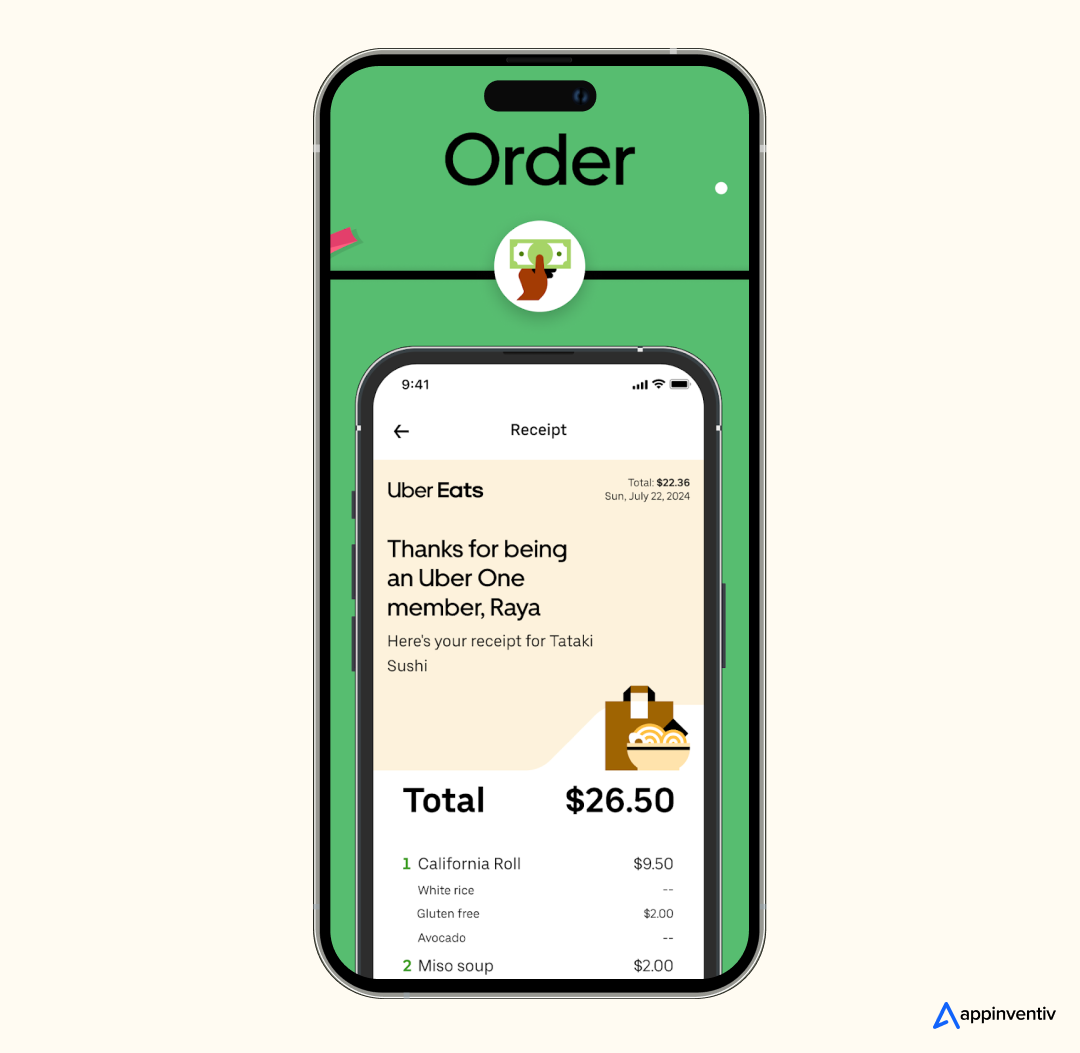
Push Notifications & Alerts
Instant updates on order status, delivery time, promotions, and security alerts to keep users informed and engaged.
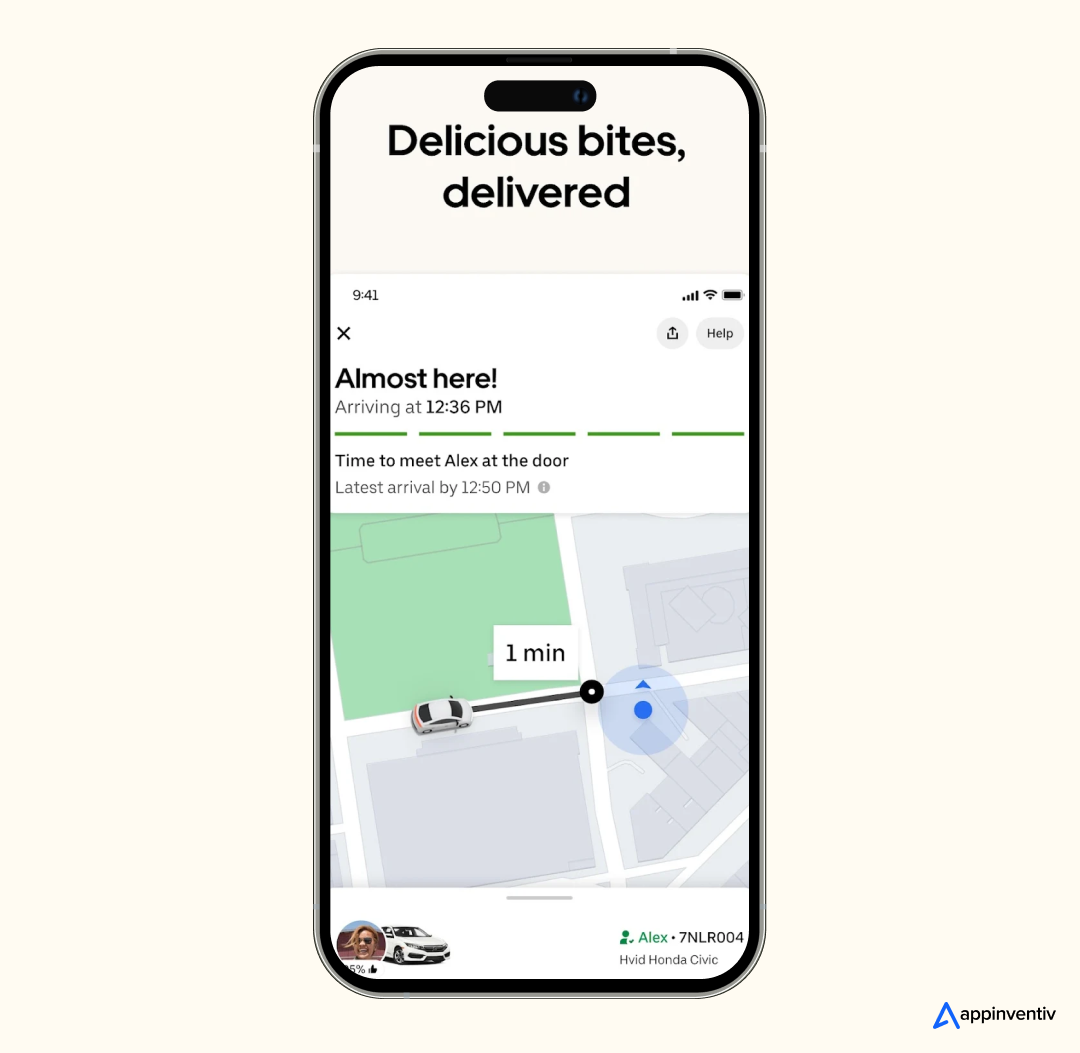
Real-Time Tracking
Live tracking of food orders from the restaurant to delivery, enhancing the customer experience with real-time updates.
Payment Integration
Secure and seamless payment options, including credit/debit cards, mobile wallets, and other payment methods.
Delivery Scheduling
Allow users to schedule orders ahead of time, providing flexibility in when they want to receive their food.
Customer Support Integration
In-app support features, such as live chat, help centers, or AI-powered chatbots, to resolve issues quickly and efficiently.
Security Features
Use of encryption, secure logins (biometric/2FA), and data protection to safeguard user information from breaches.
Grocery Order Delivery
Allow users to order groceries with real-time stock visibility, flexible delivery slots, and seamless integration with local grocery partners for faster fulfillment.
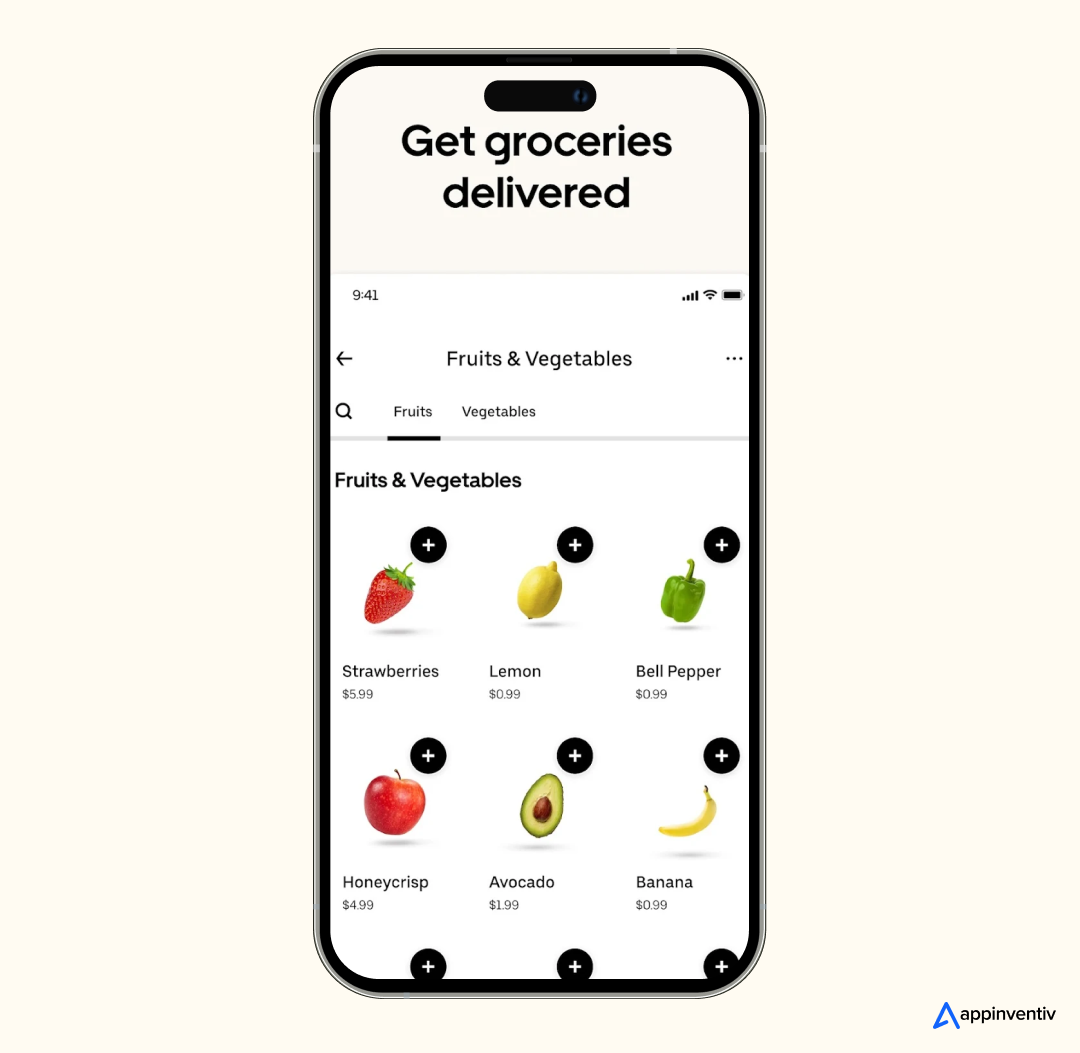
Order History & Search
Enabling users to view previous orders, save favorites, and quickly reorder with ease for a personalized experience.
Special Offers & Deals
Enable restaurants to showcase exclusive discounts, combo offers, and time-sensitive deals to attract customers and encourage repeat orders.
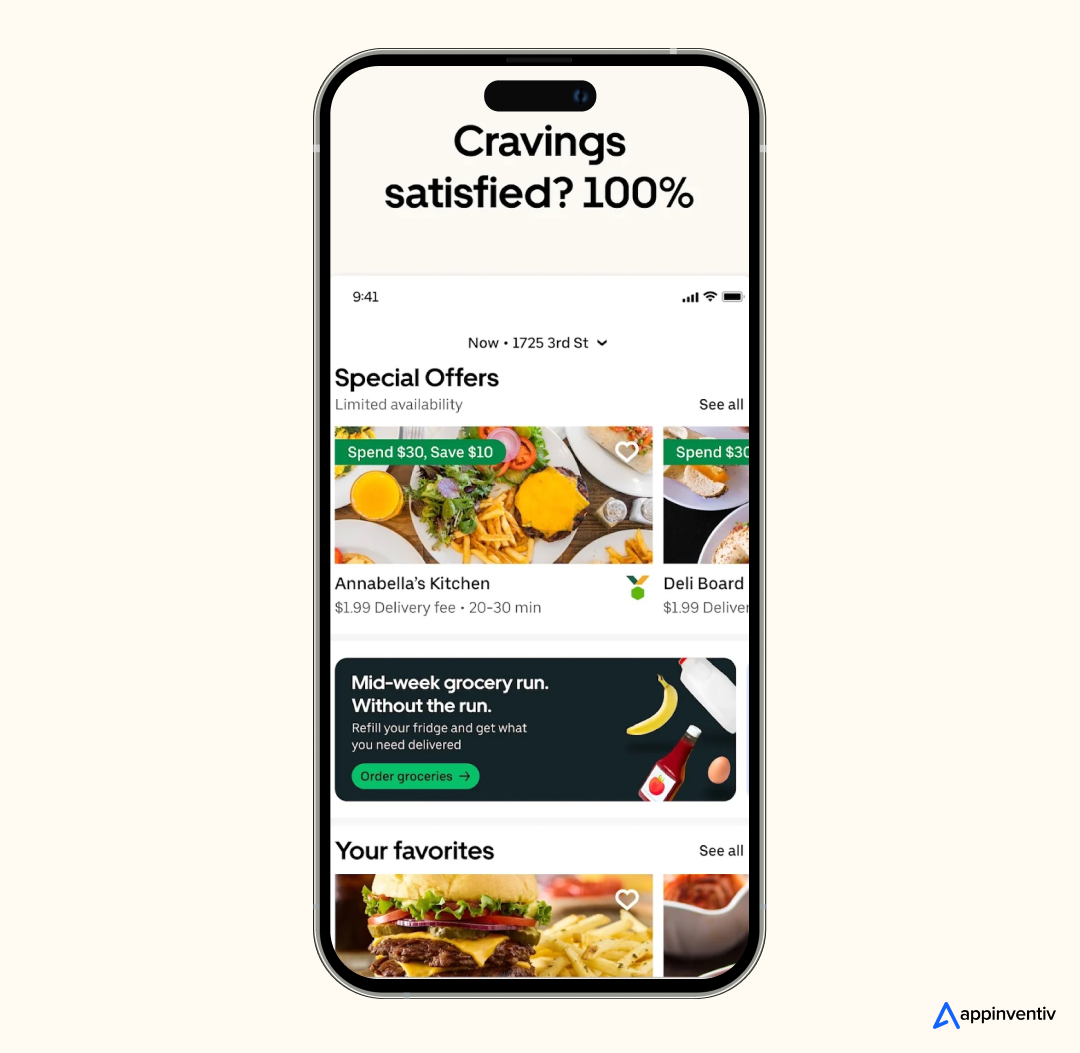
Ratings & Reviews
Users can rate restaurants and delivery drivers, helping future customers make informed decisions based on past experiences.
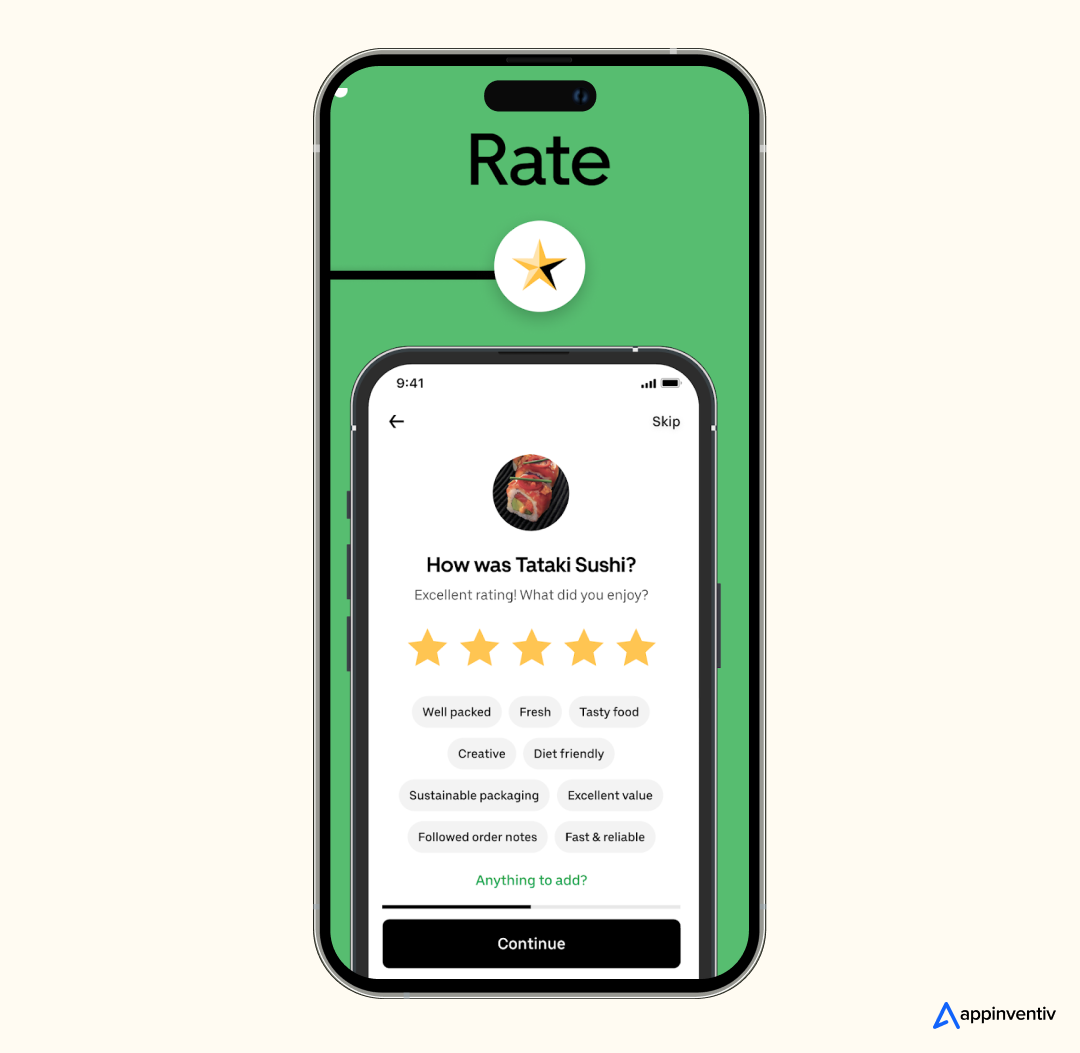
Multiple Language Support & Localization
Customize the app for various regions by offering different languages, currencies, and localized menus for a global audience.
Driver-Side Panel
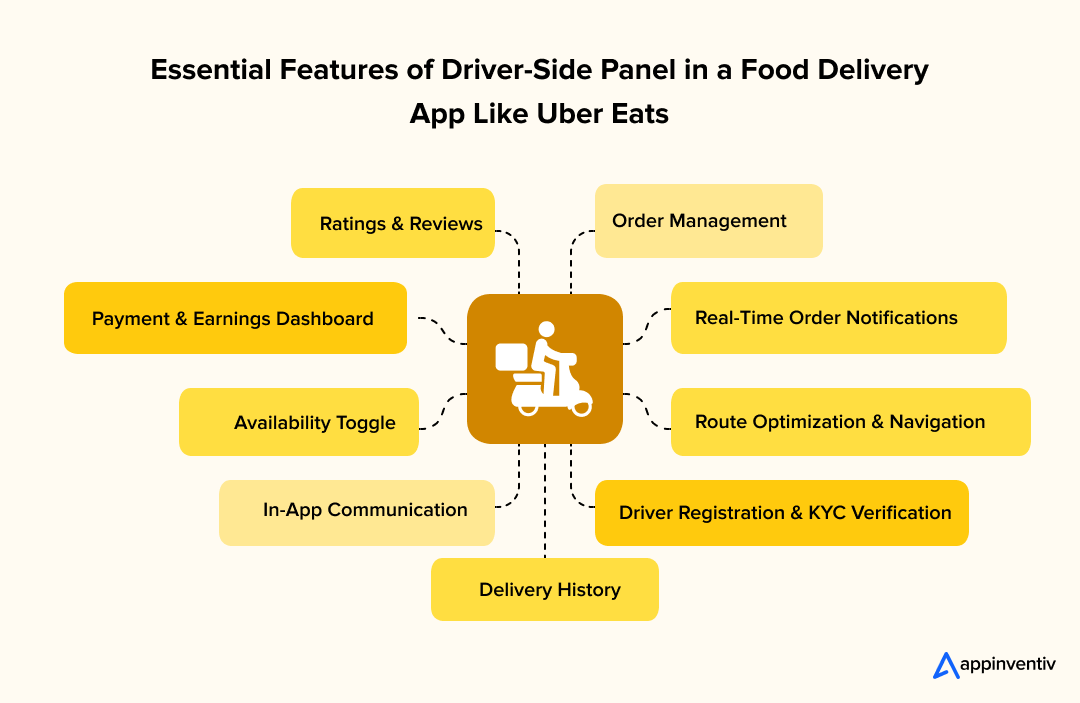
Driver Registration & KYC Verification
Secure onboarding with identity verification, license uploads, and background checks to ensure safety and regulatory compliance.
Real-Time Order Notifications
Instant alerts for new delivery requests, route changes, and updates to keep drivers informed and responsive.
Route Optimization & Navigation
Built-in GPS with real-time traffic updates to help drivers find the fastest and most efficient delivery routes.
Order Management
Easy access to order details, pick-up instructions, and drop-off locations, allowing drivers to manage multiple deliveries seamlessly.
In-App Communication
Direct chat or call functionality to connect with customers and support teams for quick issue resolution.
Payment & Earnings Dashboard
A detailed overview of completed deliveries, tips earned, payment status, and weekly or monthly earning summaries.
Delivery History
Access to past delivery records, including dates, times, locations, and payment details for performance tracking.
Availability Toggle
Allow drivers to switch between online and offline modes based on their availability, providing flexibility in work hours.
Ratings & Reviews
Drivers can view customer feedback and ratings to understand service quality and improve performance.
Admin-Side Panel
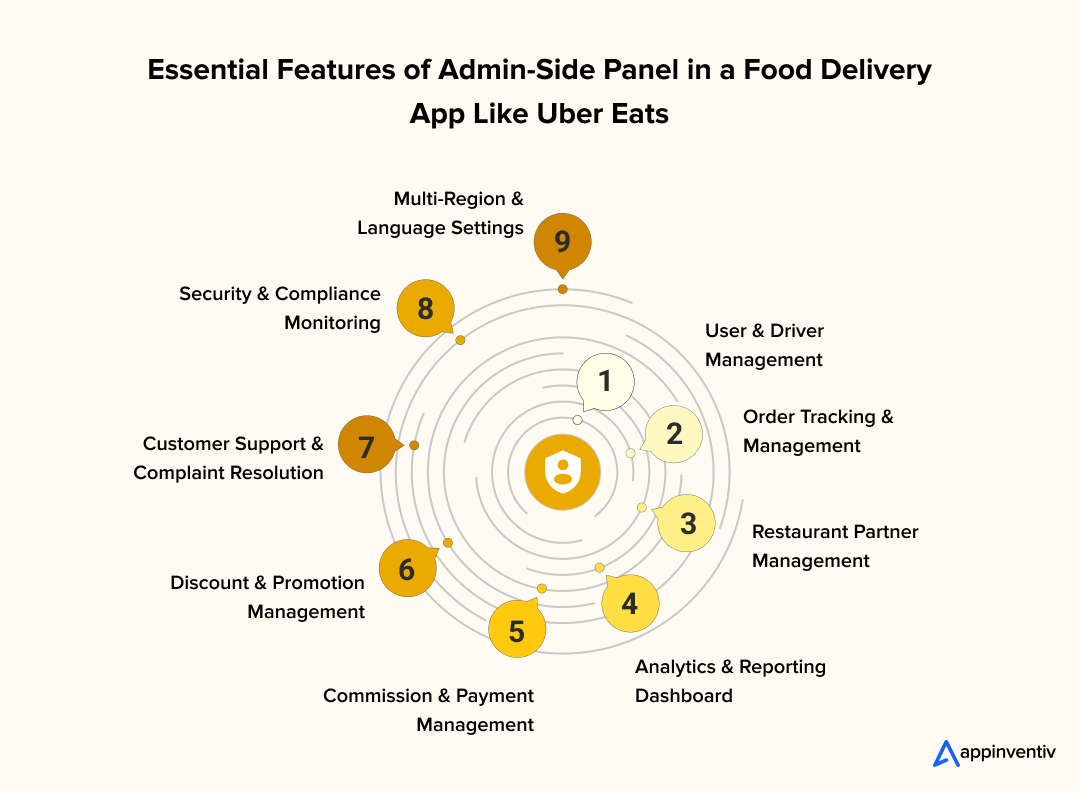
User & Driver Management
Centralized control to manage user profiles, driver registrations, verifications, and account status in real-time.
Order Tracking & Management
Real-time monitoring of all orders, from placement to delivery, with the ability to manage cancellations, delays, or reassignments.
Restaurant Partner Management
Tools to onboard new restaurants, update menus, manage partnerships, and track restaurant-specific performance.
Analytics & Reporting Dashboard
Comprehensive reports on sales, delivery times, app usage, customer retention, and driver efficiency to support data-driven decisions.
Commission & Payment Management
Set commission structures, track payments to restaurants and drivers, and manage financial records with ease.
Discount & Promotion Management
Create and manage special offers, coupon codes, and loyalty programs to attract and retain users.
Customer Support & Complaint Resolution
A dedicated dashboard to track customer and driver complaints, manage escalations, and provide quick resolutions.
Security & Compliance Monitoring
Admin access to manage app security protocols, data protection policies, and compliance with local regulations.
Multi-Region & Language Settings
Ability to manage app settings for different geographical locations, languages, currencies, and legal requirements.
Advanced Features to Elevate Your Food Delivery App Like Uber Eats
To truly stand out in today’s competitive food delivery landscape, your app needs more than just basic functionalities. Advanced features enhance security, usability, and customer engagement, making your app unique and fostering loyalty. However, integrating these features can increase the overall cost to build a food delivery app. Here are some advanced features that can elevate your Uber Eats-like platform:
| Advanced Features | Description |
|---|---|
| AI-Powered Restaurant Recommendations | Uses AI in restaurants based on user preferences, past orders, and location. |
| Real-Time Fraud Detection | AI and machine learning continuously monitor for suspicious activity, ensuring secure transactions for both users and businesses. |
| Multi-Currency & International Payment Support | Facilitate payments in multiple currencies, enabling international users and supporting cross-border transactions. |
| Voice & Chat Ordering | Allows users to place orders via voice commands or interact with AI-driven chatbots, improving convenience and accessibility. However, businesses must understand that these features can impact the overall cost to build an app like Uber Eats. |
| Order Tracking & ETA Predictions | Predict the exact time of delivery using AI and GPS technology, ensuring customers can track their food in real-time with accurate ETAs. |
| Cardless Payment & Contactless Delivery | Users can pay and complete orders without physical contact or cards, promoting convenience and reducing security risks. |
| Loyalty Programs & Custom Rewards | Implement a rewards system offering users discounts, points, or special deals to encourage frequent use and increase engagement. |
| Advanced Analytics Dashboard for Restaurants | Provide restaurant partners with an analytics dashboard to track sales, customer feedback, and optimize operations for improved service delivery. |
| Blockchain for Order Transparency | Use blockchain technology to ensure transparency in delivery tracking and payment processing, reducing fraud and improving accountability. |
Discover how we can help you integrate advanced capabilities like AI recommendations, real-time fraud detection, and contactless deliveries to lead the market.
Step-by-Step Guide to Developing a Food Delivery App Like Uber Eats
In order to make an app like Uber Eats, businesses require meticulous planning and execution. Here’s a step-by-step guide outlining the key phases involved in bringing your Uber Eats-like platform to life:
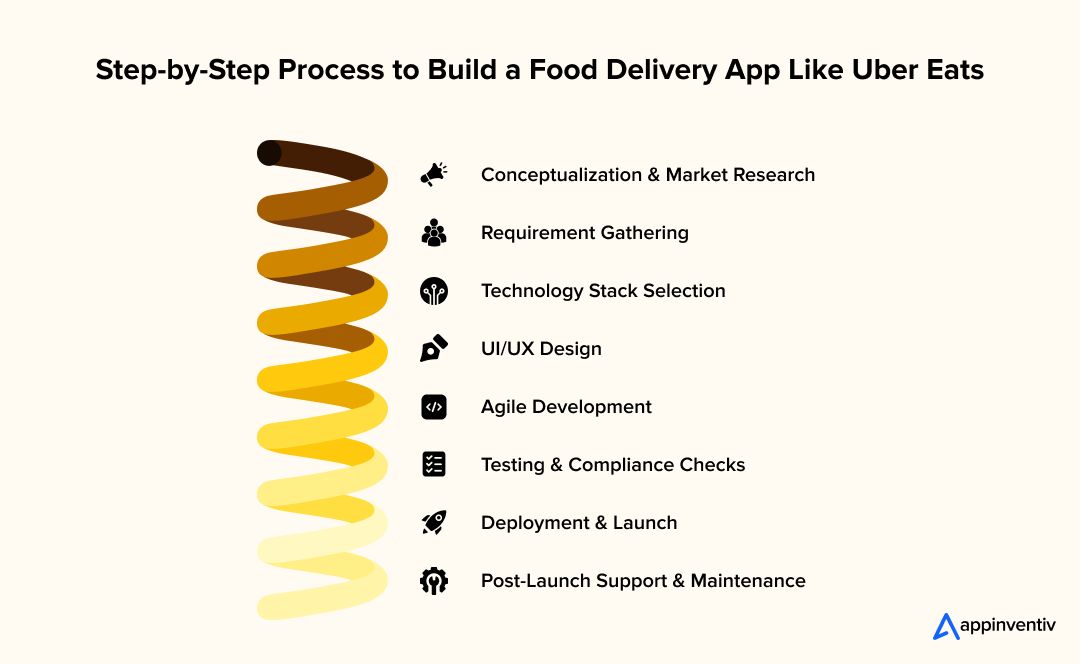
Conceptualization & Market Research
Start by clearly defining your app’s core purpose, identifying target users, and outlining your unique value proposition. Conduct market research to understand local food delivery trends, analyze competitors, and review regulatory requirements to ensure your app is market-relevant and compliant. This stage lays the foundation for building a product that connects with your target audience and aligns with real market needs.
Requirement Gathering
Translate your vision into detailed functional and technical specifications. Prioritize essential features like real-time tracking, payment integration, and restaurant partnerships, while also factoring in scalability and security. Gathering detailed requirements at this stage helps reduce costly revisions and development delays later.
Technology Stack Selection
Choose the right technologies for the backend, frontend, database, and cloud infrastructure. Opt for a stack that ensures security, scalability, and efficient integrations, such as Node.js for the backend, React Native for cross-platform support, and AWS for cloud services. Selecting the right tech stack also makes it easier to upgrade your app and scale it in the future.
UI/UX Design
Design intuitive user journeys and wireframes that prioritize ease of use. Develop visual elements consistent across mobile platforms to ensure a smooth and engaging experience for your users. A well-planned design phase improves user satisfaction and reduces the chances of users abandoning the app.
Agile Development
Follow an agile methodology, breaking development into manageable sprints. Start by building core functionalities like order placement and restaurant listings, then gradually add advanced features like AI-driven restaurant recommendations and push notifications. This approach allows for flexibility and quick adjustments based on user feedback and changing business priorities.
Testing & Compliance Checks
During this phase to create a platform like Uber Eats, conduct comprehensive testing—functional, security, and load testing—to identify and fix any issues. Ensure that the app meets compliance standards for payment processing and data protection regulations like GDPR. Extensive testing helps guarantee smooth performance across devices and ensures user trust from day one.
Deployment & Launch
Prepare necessary assets for app store submissions and set up the backend infrastructure for a smooth launch. Coordinate marketing and onboarding efforts to drive early user adoption and generate momentum from day one. A carefully planned deployment ensures minimal glitches and maximum visibility during your app’s initial release.
Post-Launch Support & Maintenance
Offer continuous support with regular bug fixes, security updates, and feature enhancements. Monitor user feedback and app performance closely to implement improvements that keep your app competitive and secure. Long-term maintenance keeps your app relevant and ensures it consistently meets evolving customer expectations.
To get more details about the development process, don’t forget to check out our blog on – Food Delivery App Development: All You Need to Know
Monetization Strategies for Food Delivery Apps Like Uber Eats
Now that you have a complete idea of the cost to build an app like Uber Eats and the roadmap to develop your Uber Eats-like app, it’s time to focus on monetization. Creating a sustainable revenue model ensures that your app not only delivers value to customers but also generates meaningful returns for your business. Here are some successful monetization strategies as per Uber Eats business model:
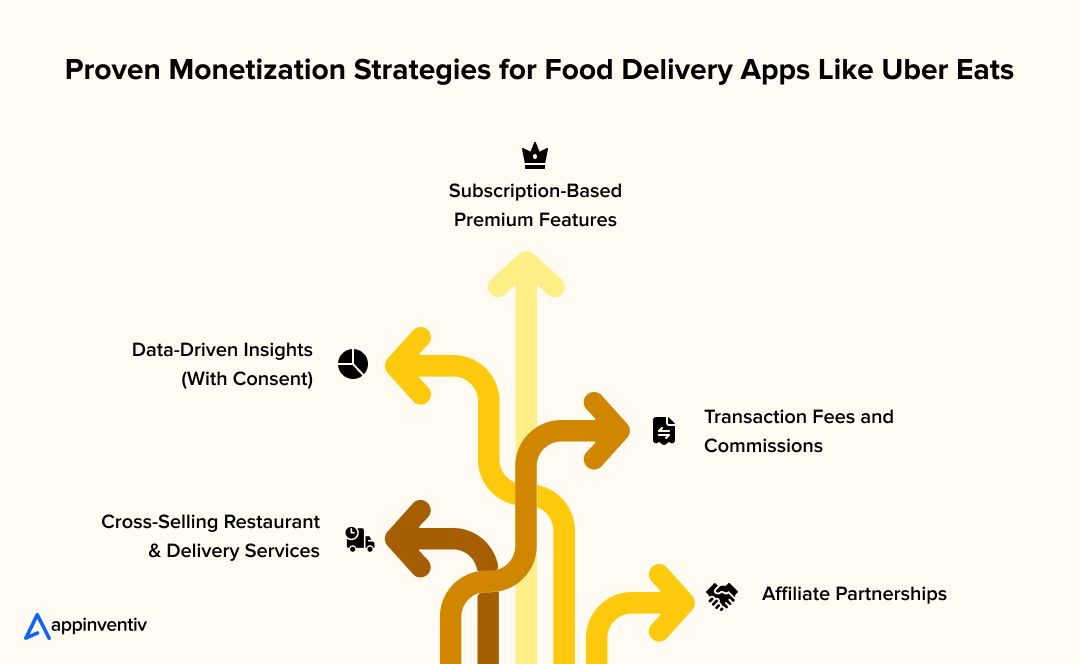
- Subscription-Based Premium Features
Offer tiered subscription plans that provide customers with benefits like priority delivery, exclusive discounts, and access to early-bird offers. This model ensures a steady revenue stream while incentivizing users to upgrade for enhanced value. - Transaction Fees and Commissions
Charge a service fee or commission on each order made through the app. A transparent and competitive fee structure can help generate income without deterring users, as long as it’s communicated clearly and fairly. - Cross-Selling Restaurant & Delivery Services
Use AI-driven insights to recommend premium services, such as faster delivery or special deals, based on customer preferences. Partnering with local restaurants to offer exclusive deals within the app can also help boost revenue. - Affiliate Partnerships
Form strategic partnerships with restaurant suppliers, beverages brands, or third-party services like mobile wallets to earn referral commissions. Integrating these services into your platform can expand offerings and provide new revenue streams. - Data-Driven Insights (With Consent)
Aggregate anonymized user data to generate valuable insights for restaurant partners or market research firms. With user consent, this data can be monetized, providing another source of revenue while respecting privacy laws.
Why Choose Appinventiv to Develop Your Food Delivery App Like Uber Eats?
We hope this guide has helped you understand the cost to build an app like Uber Eats. Now, turning that understanding into a successful app requires partnering with a development firm that combines deep industry knowledge with technical expertise. That’s where Appinventiv comes in.
As a leading food delivery app development services provider, we specialize in creating secure, scalable, and feature-rich food delivery platforms tailored to meet the unique needs of global clients. Here’s why leading food tech companies choose us to build Uber Eats-like apps:
- Food Delivery Expertise: We bring proven experience in building high-performance, secure, and scalable food delivery apps that comply with the latest industry standards and best practices.
- Security-First Approach: Our development process prioritizes security, from data encryption to secure payment processing, ensuring that user data is protected at every stage.
- Customized Solutions: Every business is unique, and we collaborate closely with you to tailor the app’s features, design, and integrations to ensure alignment with your strategic goals and customer expectations.
For instance, we partnered with KFC to build seven region-specific food delivery apps to reduce their heavy dependence on aggregator platforms. By creating a direct-to-consumer channel, we enabled KFC to achieve a 22% increase in conversion rates, over 50% direct orders, and more than 30,000 daily orders through the app. This collaboration helped KFC regain control of its digital brand and significantly boost customer loyalty.
Additionally, Pizza Hut also collaborated with us to revamp their outdated food delivery app and elevate the customer experience. We overhauled the app with a modern, scalable architecture and user-centric design, which led to a 30% increase in conversions, improved user engagement, and 50K+ app downloads. Our solutions helped Pizza Hut build a future-ready digital presence that drives consistent growth.
Furthermore, Domino’s turned to Appinventiv to solve rising bounce rates and poor app retention. By deeply analyzing user behavior and completely redesigning the UI/UX, we delivered a food delivery app that improved real-time tracking and simplified the order journey. The result was a 23% increase in conversion rates, higher in-app engagement, and reduced customer drop-offs, reinforcing Domino’s digital leadership.
Partner with Appinventiv to turn your food delivery vision into a secure, seamless, and future-ready platform that stands out in the competitive food delivery industry.
FAQs
Q. How to make an app like Uber Eats?
A. Building an app like Uber Eats requires a clear strategy and meticulous planning. Here are the key steps to develop an Uber Eats-like food delivery app:
- Conceptualize the app’s core features: Focus on essential features such as restaurant listings, order placement, real-time tracking, and secure payment integration.
- Choose the technology stack: Select the right backend and frontend technologies (e.g., React Native for cross-platform support, Node.js for the backend).
- UI/UX design: Design a user-friendly and intuitive interface to ensure a seamless ordering experience.
- Develop the app: Start with core functionalities and add advanced features such as AI-powered recommendations or customizable delivery options in later stages.
- Test the app: Perform extensive testing to ensure it meets user expectations and complies with industry standards for security and scalability.
- Launch and maintain: Deploy the app on app stores, monitor performance, and provide continuous updates for security and user engagement.
Q. How apps like Uber Eats generate revenue?
A. Apps like Uber Eats generate revenue through various monetization methods including:
- Transaction Fees: Charging a commission on each order placed through the app.
- Delivery Fees: Adding a service fee for each delivery, which varies based on distance or order size.
- Subscription Models: Offering premium services like priority delivery or exclusive discounts through subscription-based plans.
- Restaurant Partnerships: Charging restaurants a monthly or commission-based fee for listing their menu and gaining visibility on the platform.
- Advertising: Allowing restaurants or brands to advertise within the app for additional exposure.
Q. How much does it cost to build a food delivery app like Uber Eats?
A. The cost to build an app like Uber Eats can range from $40,000 to $200,000 or more depending on the complexity, features, and platforms involved. The cost will vary based on the following:
App complexity: Basic apps cost less, while those with advanced features like real-time tracking or AI recommendations increase the cost.
Tech stack: Choosing scalable cloud solutions and the right technologies (e.g., React Native, AWS) can impact both the initial cost and long-term maintenance.
Design & UI/UX: A seamless and user-friendly design that works across multiple devices can add to development costs.
Q. How long does it take to build an app like Uber Eats?
A. The timeline to build a food delivery app like Uber Eats typically spans 4 to 9 months, depending on the complexity and features. Here’s a rough breakdown:
Basic version: 3–6 months for essential features such as order placement, restaurant listings, and payment integration.
Advanced version: 9-12 months for more sophisticated features like real-time tracking, AI integration, and custom delivery options.


- In just 2 mins you will get a response
- Your idea is 100% protected by our Non Disclosure Agreement.
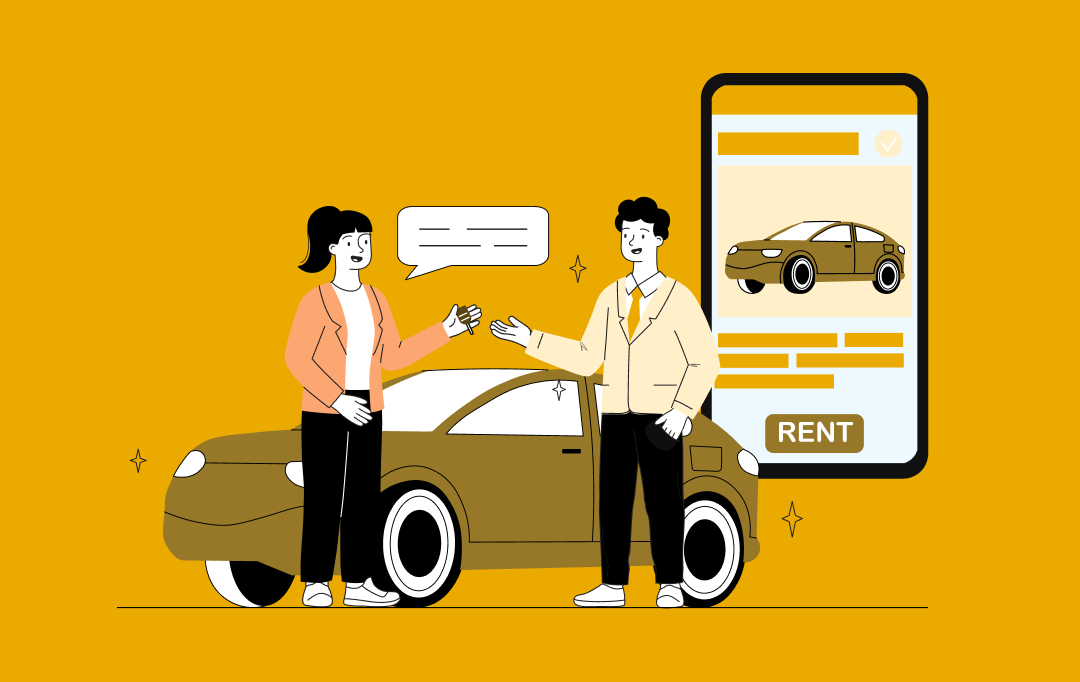
How Much Does It Cost to Build a Car Rental App like Hertz?
Key takeaways: The cost to build a Hertz-like app ranges roughly $40,000–$300,000+. Complexity, automation, and scale matter more than just the number of features. Real costs continue after launch: infra, maintenance, support, and compliance. Smart planning and MVP-first approach help keep budgets under control. Revenue comes from rentals, add-ons, subscriptions, partnerships, and fleet sales. You…
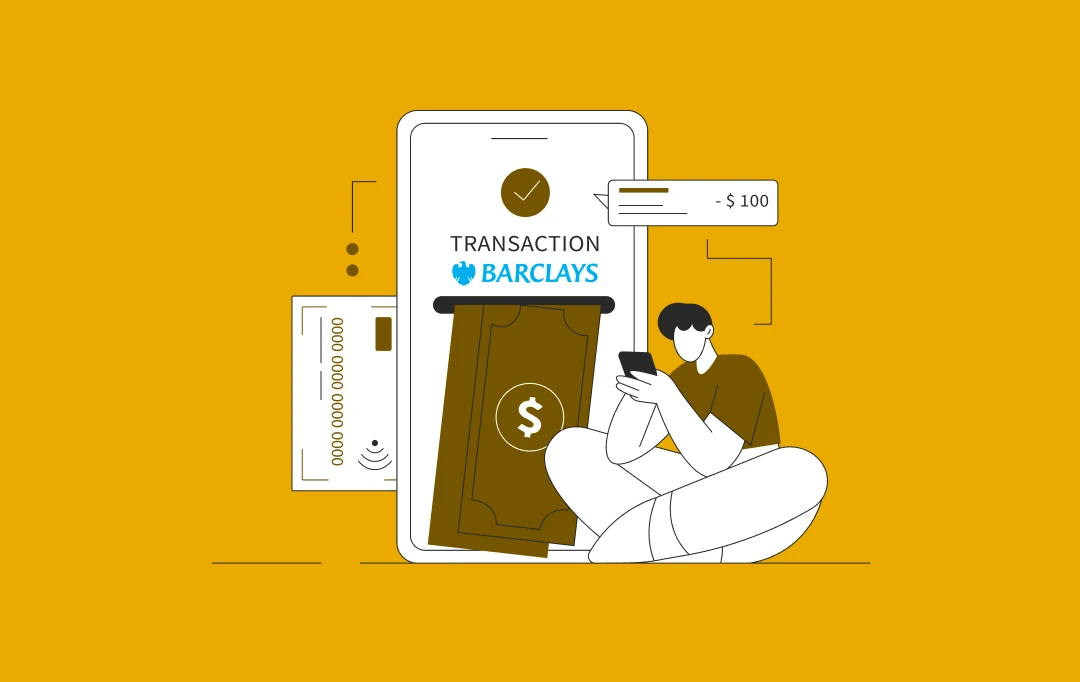
How Much Does It Cost to Build a Banking App like Barclays?
Key takeaways: Barclays sets the bar: Its speed, security, and money management tools show what EU users expect from modern banking apps. Costs vary a lot: A basic, compliant app can start around $40,000 (≈€30,000), while a feature-rich build can reach $400,000+ or more (≈€298,000+). Rules add real work: Meeting PSD2, GDPR, and instant payment…
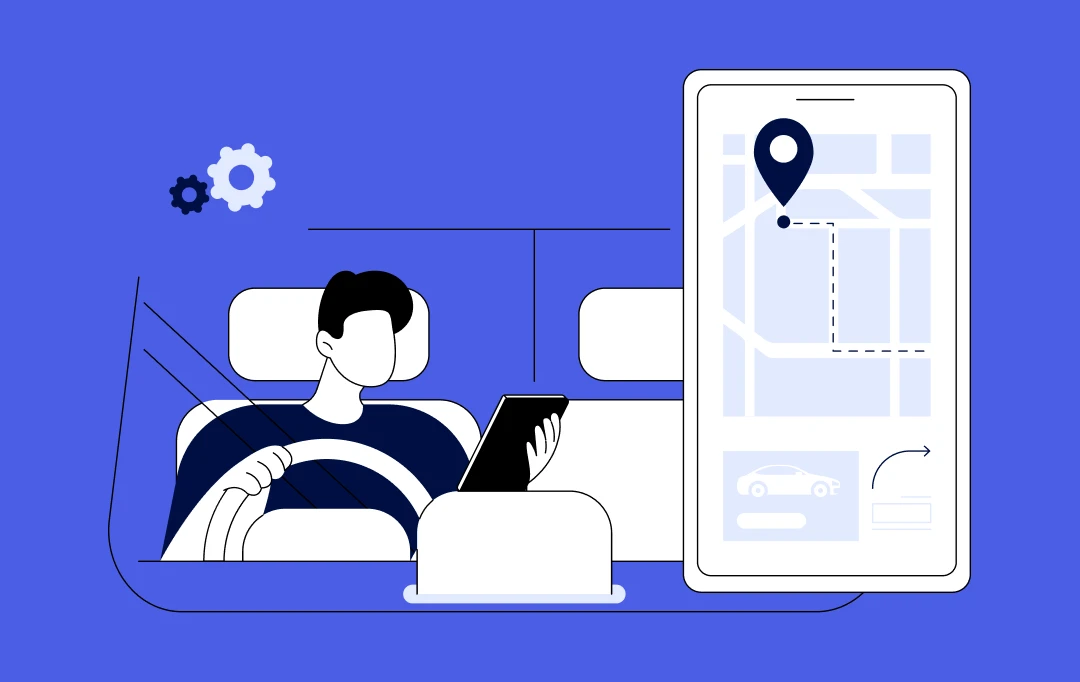
How Much Does It Cost to Build a Route Planning App Like Komoot
Europe doesn’t just love the outdoors- it thrives on it. From the Alps to Amsterdam’s bike lanes, cycling and hiking fuel an industry worth $53.3 billion in 2024, projected to grow at nearly 11% CAGR through 2033, as reported by GrandViewResearch. And leading this charge is Komoot, the route-planning app trusted by 40+ million users.…
